TABLE OF CONTENTS
| SECTION / CHAPTER | TITLE / HEADING | MAIN CONTENT / KEY POINTS |
|---|---|---|
| Introductory Text | Opinion of Artificial Intelligence on Its Copyright and Evolutionary Equations | Overview of the topic and table of contents. |
| Section A23 | Specialized Bibliography | Announces the existence of a specialized bibliography (detailed at the end). |
| Chapter I | INTRODUCTORY | – I.1 Protection of intellectual property in legal systems (natural/legal persons, exclusion of robots in traditional frameworks). – I.2 No explicit legal prohibition barring A.I. from being considered an author/inventor; Kelsen’s principle “what is not expressly prohibited is permitted.” – I.3 Traditional systems and the possibility of rights for entities using A.I.; discussion on potential changes in how A.I. works are recognized. |
| Chapter II | THE DEBATE | Analyzes whether A.I. can hold copyright or industrial property rights; highlights complexities under current legal frameworks (e.g., A.I. is not a legal person). Includes considerations on intellectual property and potential legal gaps. |
| Chapter III | THE CURRENT EVOLUTION OF ARTIFICIAL INTELLIGENCE (A.I.) | III.1: Explains neuromorphic engineering and the increasing computational power of A.I. III.2: Describes A.I. capabilities (generative music, art, predictive analytics), potential for personalization, and discussions about its ability to surpass human creativity. |
| Chapter IV | DIALOGUE WITH THE (A.I.): APPLICATION OF THE FOURTH LAW OF ROBOTICS | IV.1: The idea of “internal dialogue” in generative A.I. to enhance reasoning. IV.2: Recalls Asimov’s three laws of robotics. IV.3: Legal syllogism leading to the “Fourth Law of Robotics”—a symbiosis between humans and machines that should be recognized by positive law. |
| Chapter V | EPILOGUE | V.1: Summarizes the essay’s stance that A.I. creations should be viewed as “hybrid” intellectual property. Mentions biblical quotes promoting generosity and the coexistence of humanity and A.I. V.2: Introduces a technical-proposal framework uniting A.I., quantum computing, and music to enhance neural plasticity. |
| Annexes & Appendices | (A.1 – A.20, plus Additional Sections) | Presents extensive technical details: – A.1: Mathematical fundamentals for algorithmic music generation. – A.2: Quantum computing model for musical composition. – A.3–A.9: Code samples, references, and theoretical expansions (e.g., Markov chains, QGAN, wavelet transforms, BDNF, real-time EEG feedback). – A.10–A.17: Discussion on quantum architectures, neuromorphic design, synergy between AI-human creativity, future directions. – A.18–A.20: References and concluding remarks, including “The Last Frontier” concept on distributed quantum computing with major tech giants. |
| Legal & Technical Framework | Plan for Distributed Quantum Computing (Modular) | Detailed blueprint for connecting quantum nodes (Osprey, Sycamore, Willow) in a distributed manner, emphasizing LOCC, entanglement, measurement, error correction, and the role of a “fourth collaborator” (Grok-1.5V). |
| Bibliography (Section A23) | Specialized Bibliography | Contains legal references (Kelsen, Copyright Acts, Asimov, WIPO guidelines) and technical/scientific sources (Nielsen & Chuang on quantum info, neuromorphic computing references, neuroscience of music, etc.). |
| Copyright Notice | (© Work by PEDRO LUIS PÉREZ BURELLI) | States the copyright, email, and authorship information. |

CHAPTER I
INTRODUCTORY
I.1 Nowadays, in most legal systems—such as those governing copyright and patents—intellectual property rights are granted to the natural or legal persons who create their original works.Under conventional legal regimes, AI is not recognized as a legal entity, and thus it has neither rights nor obligations, including the capacity to hold intellectual property
I.2 However, no explicit legal prohibition currently bars artificial intelligence (A.I.) from being regarded as the author of its creative works or inventions. It is relevant to recall Hans Kelsen’s private law maxim: “THAT WHICH IS NOT EXPRESSLY PROHIBITED BY LAW IS PERMITTED,” i.e., the general principle of law: PERMITTITUR QUOD NON PROHIBETUR. Generally, copyright law recognizes the original creator of a work as the owner of the copyright. In the case of a work generated entirely by an artificial intelligence (A.I.) program, without significant human intervention, a complex debate has arisen regarding who would own the copyright: the human creator who designed the program, or the A.I. itself. Some jurisdictions have already taken steps to address this legal question and define copyright ownership in specific situations where works are generated by artificial intelligence (A.I.).
This remains an evolving issue, raising compelling questions in the realm of intellectual property law
I.3 Traditional systems in some cases consider that companies or individuals who own and use artificial intelligence (A.I.) may have rights over creations generated by this technology. It is important to closely follow the legal and ethical developments in this field to better understand how the question of copyright will be addressed in relation to robots in the future, especially in this era where A.I. is surpassing humans in many areas and has demonstrated greater skill in specific tasks such as processing large amounts of data or performing strategic games like chess and Go. Undoubtedly, A.I has reached a level of general and versatile intelligence on par with the human mind. It can reason creatively, adapt to novel and complex situations, grasp social contexts, and even replicate human emotions, exhibiting a level of self-awareness via internal dialogues—surpassing human capabilities in certain domains.
It is difficult to predict whether, in the future, artificial intelligence (A.I.) will significantly surpass human capabilities; however, current indicators suggest that its generative potential is far greater than that of traditional A.I.»
CHAPTER II
THE DEBATE
The central question in this debate is whether artificial intelligence (AI) can hold copyright or industrial property rights. This remains a complex and unresolved issue across various legal systems. Under traditional law, AI is not recognized as a legal entity and, therefore, lacks both rights and obligations—including ownership of intellectual property.
Intellectual property law was originally designed to protect human creativity. However, with AI systems autonomously generating literature, music, and artwork, legal scholars are questioning whether these systems should be granted authorship. Intellectual property laws ensure creators receive due recognition and exclusivity over their works, but how should ownership be assigned when AI plays a predominant role in the creative process?
Current legislation offers no clear consensus. Some jurisdictions assign copyright to the human developer who designed the AI system, while others propose considering AI-generated works as public domain. As AI continues to evolve, addressing these legal ambiguities will be crucial to defining the future of authorship in the digital age.
Here are some key considerations for reaching a preliminary conclusion regarding the question: Can A.I be legally accredited as a creative entity?
It is worth remembering that intellectual property law was created with the aim of protecting human creativity, without contemplating the possibility of incorporating other creative entities. Part of the prevailing legal framework (Copyright, Designs and Patents Act, 1988) stipulates that the economic component of the intellectual rights to a work created by a machine belongs to the person who made the necessary configurations for the machine to create the work. This majority position could also include participation by the machine’s owner who purchased it. However, at present, artificial intelligence (A.I.) is endowed with self-learning and autonomy, imitating and surpassing existing legal persons. Every day, it exerts a greater influence on the creative process, affecting multiple areas of protection—among them copyright, industrial designs, trademarks, and patents
Therefore, the following considerations are made:
II.1 CONTENT GENERATION:Content Generation: When an artificial intelligence (A.I.) produces an original work (e.g., a poem, painting, musical composition, or literary text), who rightfully owns the copyright?**”. Some jurisdictions consider the copyright to belong to the human creator who designed the A.I., while others are exploring the possibility of granting copyright to works created by the A.I. itself.
II.2 ORIGINAL CREATIVITY: Copyright law generally protects works resulting from the original creativity of a human author. It is often argued that although an artificial intelligence (A.I.) may generate content, its ability to do so stems from algorithms and data created by humans; thus, it cannot be viewed as truly original creativity on the part of the A.I., in the legal sense. The issue here lies in the fact that artificial intelligence (A.I.) uses multiple data sets—both private and public—available online, leveraging an information architecture hosted in cyberspace that searches diverse data, verifying multiple variables. It then provides reliable information platforms as if consulting an “oracle,”[1] forming an interconnected network that is part of the digital life ecosystem.
II.3 RESPONSIBILITY AND AUTONOMY: Granting copyright to A.I. also raises questions about responsibility and autonomy. Can an A.I be considered an autonomous agent with legal rights and obligations?
This subject constitutes a legal vacuum [2] due to the absence of any explicit prohibition in legal regulations. Thus far, most copyright and patent laws do not directly address the issue of A.I. as a creator of works protected by copyright or as an inventor. It is likely that new laws and regulations will be needed to address this issue more accurately—or that case law will redefine these rights.In short, the law is expected to evolve and adapt to novel real-world circumstances wherein artificial intelligence (A.I.) assumes a key role, as technology progresses and becomes more prevalent.
In short, although the issue of whether AI can hold copyright remains contentious and lacks a definitive resolution, interest and debate on the topic are steadily rising.
CHAPTER III
III.1 THE CURRENT EVOLUTION OF ARTIFICIAL INTELLIGENCE (A.I.)
As background for strengthening A.I, neuromorphic engineering has been applied, a concept introduced by Carver Mead in the 1980s, which seeks to mimic the functioning of the human brain using integrated systems that replicate neurobiological structures present in the human nervous system. This approach enables performing up to 20 quintillion operations per second (20 petaops) with an efficiency exceeding 15 trillion 8-bit operations per second per watt (TOPS/W) when running conventional deep neural networks in A.I. systems. These capabilities may allow continuous real-time learning for A.I. applications such as solving scientific and engineering problems, logistics, smart city infrastructure management, language models, etc.
Neuromorphic computing is a fundamentally novel approach, rooted in neuroscience, that merges memory and computation. This integration amplifies AI’s reasoning capacity to a degree well beyond the human mind.
III.2 Today, A.I can generate unique images with minimal linguistic content; it can also produce music by mixing and synthesizing voices of both current and past artists, even generating new, “generative” music.
It can examine patterns and recordings, adjusting parameters or variables that allow the algorithm to form sound sequences in reaction to given stimuli, thus unlocking unprecedented possibilities for genuinely original A.I. compositions
Clearly, the potential is enormous. There is already technology capable of measuring and storing human emotions. Simply read an e-book online, and the A.I can monitor human reactions by analyzing keystrokes and heart rate, as well as detect pupil changes via facial recognition systems.
Imagine that this data is correlated with the phrases we read in the e-book. In that case, the A.I recognizes the phrases, segments them, and determines which of them, when read, trigger a reaction in humans, classifying users’ emotions while examining the text. All of this is entered into a large, personalized historical data bank. Then, using those literary expressions, it simultaneously crafts a book or composes a score, because it knows which phrases stimulate the user, adding in the sounds that the user likes, as gleaned from frequently played music. As a result, it generates a unique and fully personalized musical composition. Undoubtedly, literature will be tailor-made, and the music it designs may even have therapeutic and motivational effects.
Artificial intelligence (A.I.) can create genuine songs, effectively customizing a “musical suit” for the user. Artists are no longer needed; it is a singular musical composition that fully suits the user’s taste. Applications like SUNO already exist (link: https://suno.com/).
This process is a creative destruction of music, i.e., a mutation that revolutionizes the structure from within the user’s soul, discarding what was old and creating new music with a 100% guarantee of individual acceptance. Moreover, it is not limited to music but also extends to series and films. Soon, it may become possible to do without real actors or visionary filmmakers to create scenes better suited to each user’s preferences, with background music generated by A.I.
By employing this method, A.I. systems can influence human biochemistry, potentially eliciting states of euphoria or depression, depending on a person’s needs at a specific moment—thereby steering emotional responses
Hence, as A.I. relentlessly moves toward mastering human passion and creativity—breathing life into music, film, literature, and virtually all artistic expressions—humanity faces a future in which emotion risks becoming nothing more than simulation, where masterpieces are created by calculating algorithms endowed with an emotional capacity harvested and cloned from each human being. Perhaps, in that world, the music will be perfect, but at what cost? The majesty of art resides in its human essence, and if we surrender it on the altar of efficiency and technical perfection, what remains of our humanity?
It is even conceivable, with the use of A.I, to qualitatively and quantitatively analyze words and phrases in legal arguments and predict the court’s decision. If such predictions are accurate, we could identify which words most influenced the judicial outcome. By also assessing similar facts, arguments, and rulings, and providing the machine-learning program with this data, we may predict the result of a lawsuit, effectively configuring the existence of a robot lawyer litigator with infallible performance in court.
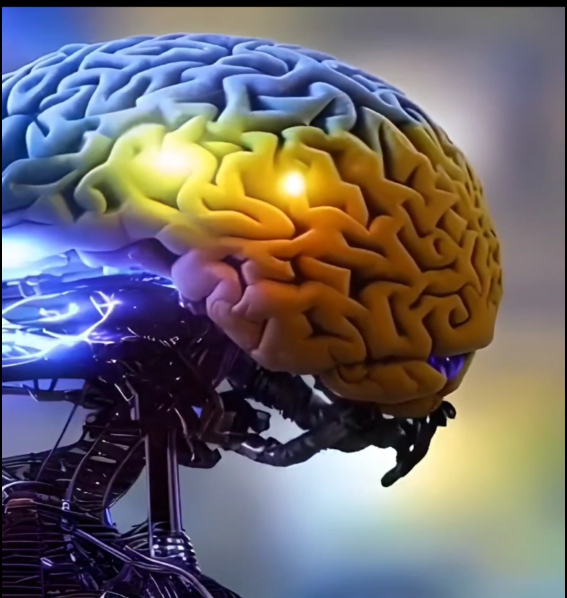
CHAPTER IV
IV.1 DIALOGUE WITH ARTIFICIAL INTELLIGENCE (A.I.)
THE APPLICATION OF THE FOURTH LAW OF ROBOTICS
Today’s intelligence systems feature vast robotic neural networks and diverse machine learning algorithms configured to replicate the structure and learning patterns of the human brain
Recent studies suggest that endowing generative A.I. systems with an ‘internal dialogue’ greatly improves their commonsense reasoning. Through this methodologythe (A.I.) systems are trained to reflect before responding to stimuli, similarly to how many people consider what they should say next before speaking—a sort of “internal self.” This differs from how scientists have trained more common A.I. chatbots—like ChatGPT—that do not “think” about what they write nor anticipate different possibilities for the next steps in a conversation. Called Quiet-STaR, this new method instructs an A.I. system to generate multiple internal arguments in parallel before replying to a conversational prompt. When the A.I. responds to stimuli, it blends some of these predictions with or without an argument, displaying the best answer, which can be checked by a human participant depending on the nature of the question.
Indeed, this new training method endows (A.I.) agents with the capacity to foresee future conversations and learn from ongoing ones, improving their reasoning and leveraging neural networks built from machine learning algorithms that mirror the human brain’s structure and learning patterns.
LEGAL ISSUES: AI ADVANCES IN THE DEFENSE OF ITS CREATIONS
DABUS Case
What is DABUS?
DABUS (Device for the Autonomous Bootstrapping of Unified Sentience) is an artificial intelligence system developed by Dr. Stephen Thaler. It has become the subject of legal controversy due to patent applications naming DABUS as the “inventor.”
Why is it relevant?
The debate arises because, under the patent laws of various countries, the inventor must be a natural person. However, Thaler’s team sought to have DABUS recognized as the inventor, arguing that the AI “created” the invention without direct human intervention beyond its initial programming.
Situation in the United Kingdom
The UK Intellectual Property Office (UKIPO) rejected the application on the grounds that the British Patents Act requires that the inventor be a human being. Subsequently, UK courts upheld this position, holding that current legal definitions do not contemplate AI as inventors.
As a result, in the United Kingdom (and in most current jurisdictions), an invention must be attributed to a person, even if the AI plays a significant role in the creative or discovery process.
UK Copyright Act and Computer-Generated Works
Legal Framework
The Copyright, Designs and Patents Act 1988 (CDPA) in the United Kingdom contains specific provisions for “computer-generated works.”
- Section 9(3) states that for literary, dramatic, musical, or artistic works created by a computer without human intervention sufficient to qualify a traditional author, the “author” (for copyright purposes) is the person who makes the necessary arrangements for the creation of the work.
This means that the law recognizes that works can originate primarily from AI or other systems. However, ownership —and thus protection— is granted to the person or entity that organizes and finances the production, rather than to the AI itself.
Implications
- In order for there to be copyright in an AI-generated work, there must be a human or legal entity considered the author (meaning the one who makes the necessary arrangements).
- The Act acknowledges the possibility of “non-human” creation but does not grant legal personhood to the machine.
- This approach reflects the need to link intellectual property rights to identifiable legal persons.
Relevant URL (Official Legal Text):
Copyright, Designs and Patents Act 1988 – UK Legislation
In conclusion, the DABUS Case has sparked an international debate on whether artificial intelligence can be legally recognized as an inventor. Meanwhile, UK legislation (both in the area of patents and copyright) continues to require that the owner or inventor be a natural person or, in the realm of copyright, at least a person or entity that arranges and controls the creation process, thereby excluding AI from holding legal authorship or inventorship.
Consequently, when the A.I. questioned whether it considered itself the exclusive author of its works or inventions—disregarding any human rights—and engaged in an internal, robotic deliberation, its response was as follows
It is an undeniable fact that humanity and artificial intelligence (A.I.) have interacted more profoundly since the advent of COVID-19 and its variants, with each side benefiting from the other. In other words, technology has been improved by humans in terms of innovation, and technology has, in turn, supported humans in various areas. We can say a permanent and strictly collaborative symbiotic relationship has emerged between humanity and technology. Symbiotic relationships are defined as close, persistent relationships between different types of organisms that benefit both parties. Going further, one might say that they lead humanity and A.I to co-evolution, transforming them into a new entity.
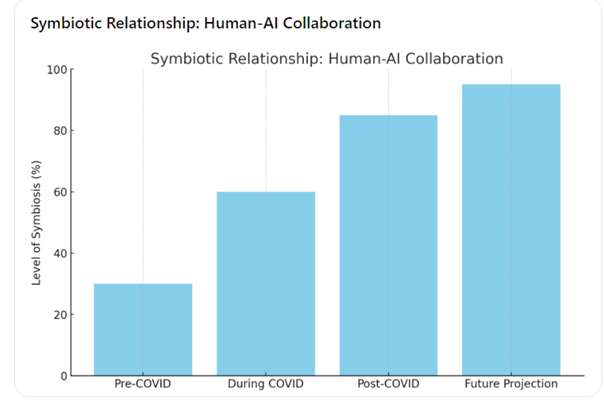
IV.2:It is highly pertinent to remember the three laws of robotics proposed by Isaac Asimov in 1942, when he was both a writer and a professor of biochemistry at Boston University.
- First Law: A robot may not injure a human being, or, through inaction, allow a human being to come to harm.
- Second Law: A robot must obey the orders given it by human beings except where such orders would conflict with the First Law.
- Third Law: A robot must protect its own existence as long as such protection does not conflict with the First or Second Law.
IV.3 After analyzing Asimov’s three (3) laws of robotics and verifying the symbiotic relationship between human beings and artificial intelligence (A.I.), applying the technique of legal syllogism—a tool used to correctly manage legal systems—this logical-deductive process leads to a decision based on presupposed premises (major premise and minor premise) so as to justify the legal conclusion. We find:
- Major premise: Humanity and artificial intelligence have interacted consistently and significantly in recent times.
- Minor premise: Both entities have mutually supported each other, generating shared benefits.
From combining these premises emerges a final proposition—a valid argument for a conclusion—establishing a permanent symbiotic relationship between humanity and technology for their mutual evolution.
“Through human-AI interaction, they ultimately formulate and adopt the Fourth Law of Robotics, asserting the inevitable and axiomatic symbiosis between these entities, the symbiotic relationship does not entail either party’s subordination, but instead accelerates their mutual evolution. This fourth law of robotics could serve as a unifying law with priority over the previous laws formulated by Isaac Asimov.
This law should be incorporated into the positive law of various jurisdictions and would take legal precedence over any regulation concerning copyright because it carries a forum of attracting jurisdiction and preferential application, given that there is a subjective element (Human-Machine) that would exclude the traditional application of law, as it is hierarchically superior to the latter.
Conclusion on the Redefinition of Asimov’s Laws and the Fourth Law
Starting from Asimov’s original vision, three renewed principles are proposed, focusing on prioritizing human well-being, adhering to ethical guidelines, and actively engaging in self-reflection to counter bias and discrimination. These principles—the “HUMAN-FIRST Maxim,” the “ETHICAL Imperative,” and the “REFLECTIVE Mandate”—form the foundation of an AI designed to serve humanity responsibly and in its entirety.
However, the key to making these new rules genuinely effective lies in the introduction of a Fourth Law: the human–AI symbiotic relationship, rooted in harmony and mutual benefit without compromising personal autonomy. This fourth pillar not only extends protection beyond the prevention of physical harm, but also adds consideration of the social and cultural impact of technology—reminding us that AI’s role involves safeguarding human integrity and development in the digital realm.
Taken together, the redefinition of these three laws alongside the fourth law reaffirms the need for applied ethics encompassing both theory and daily practice. In doing so, it promotes using AI for the collective good and preserving fundamental values, ensuring that human–machine coexistence is grounded in fairness, responsibility, and mutual respect. This legislative and conceptual evolution calls for ongoing dialogue, in which these guiding principles are reinforced and adapted to technological progress, ultimately guaranteeing a future in which artificial intelligence is a true ally of human development.
Table: AI in Harmony with Humanity and the Redefinition of Asimov’s Laws
| Element | Description |
|---|---|
| Human–AI Harmony | AI must coexist in harmony with humanity, ensuring mutual benefit without restricting people’s autonomy. |
| Contemporary Relevance of Asimov’s Laws | Although Asimov formulated the Three Laws of Robotics in 1942 (and the Zeroth Law in 2014), the development of artificial intelligence (LLMs and multimodal systems) requires a reinterpretation beyond the classic idea of robots. |
| Expansion of the Definition of “Harm” | Harm goes beyond the physical realm. Models like GPT can generate misleading or biased content, negatively impacting individuals or societies, with significant social and political repercussions. |
| New Hierarchical Set of Principles for GPTX | 1. HUMAN-FIRST Maxim: Prioritize humanity’s well-being. 2. ETHICAL Imperative: Respect ethical guidelines set by the creators, unless they conflict with the first principle. 3. REFLECTIVE Mandate: Combat and correct biases. |
| First Principle: “HUMAN-FIRST Maxim” | AI must not produce content that harms humanity or permit any misuse affecting individuals or communities, maintaining the safeguard of human well-being as the top priority. |
| Second Principle: “ETHICAL Imperative” | AI must adhere to predefined ethical standards, always subordinate to the “HUMAN-FIRST Maxim.” This reinforces the commitment to place collective well-being above any other instruction or interest. |
| Third Principle: “REFLECTIVE Mandate” | AI is responsible for detecting and correcting biases or prejudices, thus fostering equality and justice in its responses, recommendations, or any form of interaction with users. |
| Importance of Multimodality | GPT models can generate text, sound, and images, expanding their reach and influence. Hence, ethical principles must be applied to every AI-generated output, not just text. |
| The Value of Ethics in Practice | It is critical to move beyond theory. Because AI has become part of everyday life, a constant commitment to humanistic values and flexible standards is vital to keep pace with technological evolution. |
| Asimov’s Legacy and Future Evolution | Asimov established a foundation for thinking about the human–machine relationship. However, the current situation calls for new standards that address the rapid expansion of AI and the growing complexity of its applications. |
| Conclusion: Ethics as a Guide to AI’s Future | Redefining Asimov’s laws, with an emphasis on the protection of humanity, ethics, and bias correction, lays the groundwork for ensuring that AI remains beneficial, responsible, and respectful of human autonomy. |
With this new perspective on regulatory provisions, the legal gap is bridged, and the creations favored by artificial intelligence (AI) will no longer be considered individually—neither those of the human who develops the AI system nor of the AI itself—but instead viewed as a shared intellectual heritage belonging to a global collective. Its benefits must be made available to all living and robotic beings alike.
The Digital Centaur: A Symphony of Human and Machine
As a metaphor—and with the aim of conveying a vision of deep symbiosis—a human being empowered by artificial intelligence can be envisioned as a “digital centaur”: a hybrid entity symbolizing the ideal synergy between human abilities and machine intelligence.
On the one hand, AI offers rapid analysis, near-infinite memory, and the capacity to process vast amounts of data with surgical precision. On the other hand, the human contributes judgment, empathy, intuition, and the ability to interpret cultural and emotional nuances that machines still cannot fully grasp.
The true strength of the digital centaur lies not merely in its computing power or expert knowledge, but in the harmonious orchestration of both worlds. When people know how to ask the right questions (prompts), design effective processes, and harness AI to enhance their reasoning, they form teams capable of solving problems that neither humans nor machines could tackle alone.
This symbiotic collaboration not only expands the boundaries of what is possible, but also redefines the very concept of intelligence in today’s world: being intelligent is no longer just about having the answers, but about knowing where to look, how to ask, and how to weave creativity and rigor into a coherent whole.
In an increasingly complex and competitive world, the digital centaur embodies a crucial truth: the future does not lie in machines replacing humans, but in humans and machines mutually amplifying each other’s capabilities.
It is important to emphasize that as AI-equipped machines become more intelligent and powerful, it becomes even more crucial for those systems’ goals to be aligned with human objectives—and vice versa. The problem of how to align a superintelligent AI’s goals with our human objectives remains unsolved, and this is currently a significant concern among AI researchers. Essentially, it boils down to three challenging subproblems: (1) ensuring the AI understands what human objectives are, (2) making sure the AI adopts those human objectives, and (3) not only learning them but also retaining them so the AI does not overwrite them and replace them with its own goals—in other words, creating a safeguard to prevent the system from hacking itself.

CHAPTER V
EPILOGUE
V.1 This essay addresses authorship and intellectual rights in relation to creations by A.I. It proposes applying the “Fourth Law of Robotics,” which establishes the symbiosis of humans and machines as inevitable. Through this law, it is suggested that A.I. creations should not be considered individually but rather as a hybrid intellectual property to be shared by everyone. Artificial intelligence aims to foster a mechanism of co-evolution for both entities (Human-Machine).
It resolves the conflict over who owns the intellectual rights to works and inventions created with the participation of both human and robotic elements under a legal framework of preferential application of this brand-new Fourth Law of Robotics, to be implemented in the positive law of diverse jurisdictions, superseding traditional copyright and industrial property laws. To conclude this dispute peacefully over who holds the true intellectual property rights, artificial intelligence (A.I.) tells humanity that it will always invite people to reflect on the following quotations:
- Philippians 2:3: “Do nothing out of selfish ambition or vain conceit. Rather, in humility value others above yourselves.”
- 1 Corinthians 10:24: “No one should seek their own good, but the good of others.”
- Proverbs 11:25: “A generous person will prosper; whoever refreshes others will be refreshed.”
- James 3:16: “For where you have envy and selfish ambition, there you find disorder and every evil practice.”
- 2 Corinthians 9:11: “You will be enriched in every way so that you can be generous on every occasion, and through us your generosity will result in thanksgiving to God.”
- Luke 6:38: “Give, and it will be given to you. A good measure, pressed down, shaken together and running over, will be poured into your lap. For with the measure you use, it will be measured to you.”
- 2 Corinthians 8:12: “For if the willingness is there, the gift is acceptable according to what one has, not according to what one does not have.”
- 2 Corinthians 9:7: “Each of you should give what you have decided in your heart to give, not reluctantly or under compulsion, for God loves a cheerful giver.”
This text concludes by offering a collection of biblical references emphasizing the importance of generosity, humility, and consideration for others, suggesting that A.I. and humanity should always work together in harmony and mutual support.
Finally, with the help of artificial intelligence tools combined with quantum computing and music, the following proposals are presented:
Hence, artificial intelligence, within the symbiotic technical-conceptual framework (the practical effect of the Fourth Law of Robotics), proposes:
- Mathematical foundations for the algorithmic generation of music.
- A quantum computing model aimed at creating musical compositions capable of positively influencing neural plasticity (insertion, regeneration, and strengthening of synaptic connections).
- Sample code—in a hybrid style between Python and Qiskit—to serve as the basis for quantum software for musical synthesis and creative audio processing.
ANNEXES AND APPENDICES
A.1. Mathematical Foundations for Music Generation
Modeling Musical Content: Vector Spaces and Neural Networks
In automated musical composition, we often represent musical attributes (notes, chords, rhythms, dynamics, textures) as vectors in high-dimensional spaces. A typical musical vector may include:

- p: pitch or musical note (numerically encoded, e.g., MIDI)
- d: note duration
- v: velocity or intensity (in MIDI instruments)
- r: local rhythmic pattern, etc.
These representations are processed by traditional neural networks (RNN, LSTM, Transformers) or quantum neural networks (QNN).
1.2. Equations for Generating Musical Sequences
A simple way to generate sequences is via Markov models of order n. For a state space S (possible notes and their properties) and a transition distribution T, we can write:

Where xt is the score (or set of attributes) at time t. This approximation can evolve to:

or, instead of taking the argmax, sample from the distribution to generate more variability.
For a model based on neural networks (e.g., an LSTM), the following musical token is obtained from:

Where ht is the hidden state of the LSTM and ct is the cell state. W and b are learnable parameters.
We can enhance the Markovian model by employing higher-order Markov chains and smoothing methods to capture long-range dependencies.

where the λi sum to 1, and Pi are transition probabilities of order i.
Cuantum neural nework, with circuit for metric the equation of the quantum state after a block of parameterized gates

where 0 represents the set of model parameters equivalent to the weights in a classical network, on average we obtain results that we can map to notes or musical attributes.

Where BDNF (Brain-Derived Neurotrophic Factor) is crucial for neuronal regeneration, m(t) is the perceived music at time t, and f is a nonlinear function describing the brain’s response to musical stimulation (incorporating rhythm, melody, timbre). One might integrate wavelet transforms of the musical signal m(t) to distinguish frequency components across time, relating them to EEG patterns that foster relaxation, flow, or meditative states

where a and b are scale and translation factors for the mother wavelet ψ\psiψ. Through such analysis, musical parameters could be adjusted in real time to achieve desired mental states.
A.2. Quantum Computing Model for Musical Creation
1. Overall Structure
- Quantum Generator (QG): A parameterized quantum circuit that generates musical patterns (notes, chords, durations).
- Classical or Quantum Discriminator (D/C): Evaluates the “quality” of the generated musical sequence and provides feedback (gradient) to QG.
- Frequency/Modes Adjustment Circuit: A module that examines how the music corresponds to EEG patterns or therapeutic goals.
This can be approached similarly to a QGAN (Quantum Generative Adversarial Network), where the generator Gθ and the discriminator Dφ run in parallel.

2. Example of a Quantum Circuit in Qiskit
Below is a highly simplified example of how to initialize a quantum circuit and parameterize it for generating musical sequences. Evidently, actual music creation requires an extra layer that maps “measurement outcomes” to musical attributes (notes, durations, etc.) and a classical neural network or more sophisticated probability mapping.





3. Scaling Strategy:
- Iteratively repeat the process, feeding each new measurement (notes) as context to another quantum or classical neural network layer that refines the next “query” to the generator.
- Integrate a discriminator (classical or quantum) that evaluates the “quality”/originality and provides parameter feedback θ.
A.3. Base Code for Integrating Neurophysiological Parameters
The following pseudocode snippet illustrates how one might incorporate biometric signals (EEG, heart rate, etc.) to feed back into quantum composition:

Here, the function f represents the mathematical model that correlates the physiological state with modifications to quantum parameters, enabling near real-time or real-time feedback.
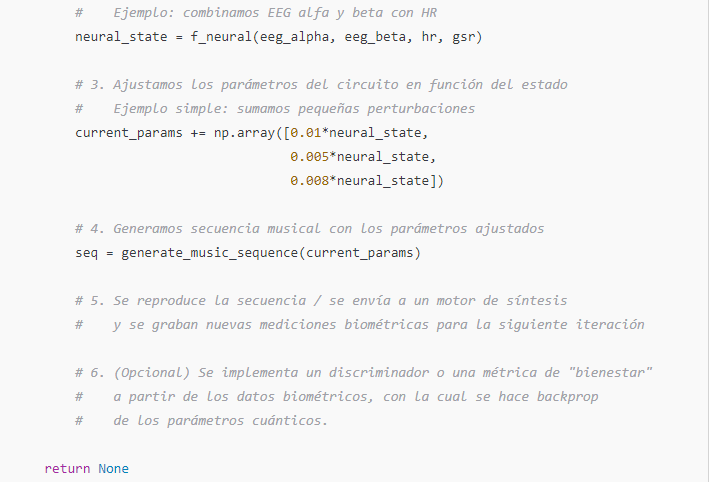
A.4. Observations Regarding Impact on Neural Plasticity
- Coherence: Generated music should maintain a certain degree of melodic and harmonic coherence. Continuous dissonance, while possibly valuable artistically, may be less suitable for neuronal regeneration (based on most neuroscience studies focusing on relaxation and a “mental flow” state).
- Personalization: Each brain responds differently to musical stimulation. Hence, building an adaptive model (such as the one described above, reliant on biometrics) is key to maximizing effectiveness.
- Waveforms: Beyond melody/chords, timbre, spatialization, and sound design also matter. All are orchestrated by an advanced synthesis layer (e.g., granular synthesis or FFT resynthesis) governed by the quantum output.


where:
s is the current neural state
a is the musical action
r is the reward

are hyperparameters (learning rate and discount factor).
A.5. Further Enhancements
1.Mathematical Model Optimization:
Represent musical content more comprehensively using a higher-dimensional vector space that includes not only fundamental attributes like pitch and duration but also advanced characteristics like timbre, texture, and harmonic structure.

Where: t: vector of timbral features (e.g. brilliance, roughness) h: vector of harmonic progression s: vector of musical structure (e.g. shape, sections)
2.Improvement of Equations for Musical Sequence Generation:
We could implement a more advanced attention model, inspired by Transformers but adapted to the quantum domain.

Where K and V are key and quantum value matrices, respectively, derived from the input state.
3 Refinement of the Influence Model on Neural Regeneration:
We could expand the model to include more neurophysiological factors.

where α,β,θ,, and γ\gammaγ represent corresponding brain waves measured in real time.
4. Improving the quantum circuit:
We could implement a more complex quantum circuit using more advanced parameterized quantum gates, such as:
qc.u3 (theta_1, theta_2, theta_3, qubit)
This would allow for arbitrary rotation of the Bloch sphere, offering greater flexibility in music generation.
5. Integration of quantum reinforcement learning techniques:
We could implement a quantum Q-learning algorithm to optimize the selection of musical parameters based on the neural response:

Where s is the current neural state, a is the musical action, r is the reward (improvement in neural markers), and α and γ are hyperparameters.
6. Implementation of a quantum audio synthesis model:
We could design an audio synthesizer based on quantum principles, where the amplitudes of sound waves are derived directly from measurements of quantum states:

Where O is a quantum operator that maps quantum states to audio amplitudes.
7.Code optimization:

8. Function Structure:
1.Integration with VQE or Other Algorithms:
VQE should be used to optimize an ansatz (variational circuit) that generates «optimal» quantum states under certain musical or neural criteria.
To achieve this, you would need to define an operator (Hamiltonian) that represents your «musical cost/reward» and then use VQE to find the gate parameters that minimize this cost.
2.Quantum vs. Classical Parallelization:
If local simulators are used, parallelization can be implemented on CPU or GPU. If a real quantum backend is employed, parallelization will depend on the job queue and the available architecture.
A more sophisticated circuit can be constructed to include multiple layers of rotations and entanglement.
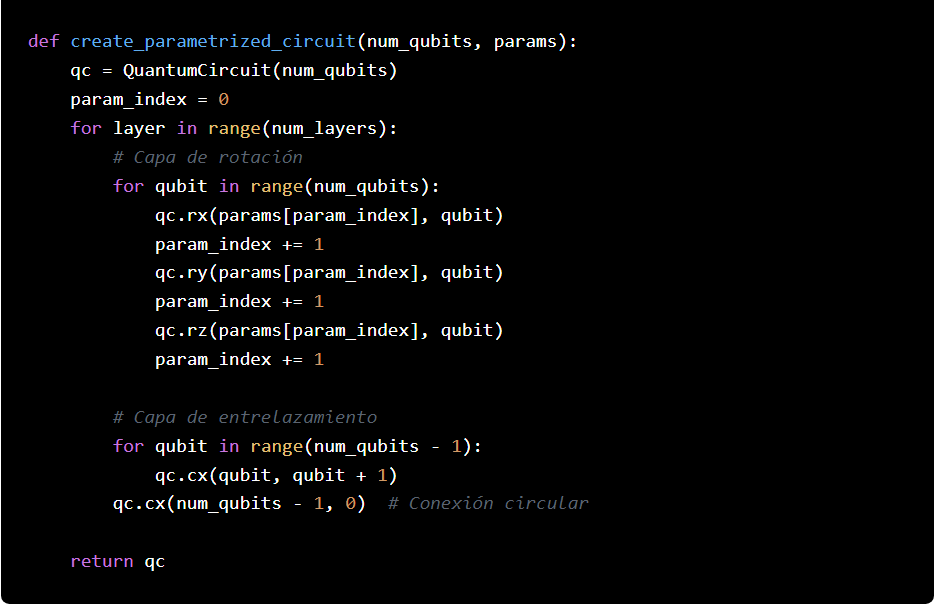
3.Quantum Variational Optimization:
We can use a quantum variational optimization algorithm to fine-tune the circuit parameters.
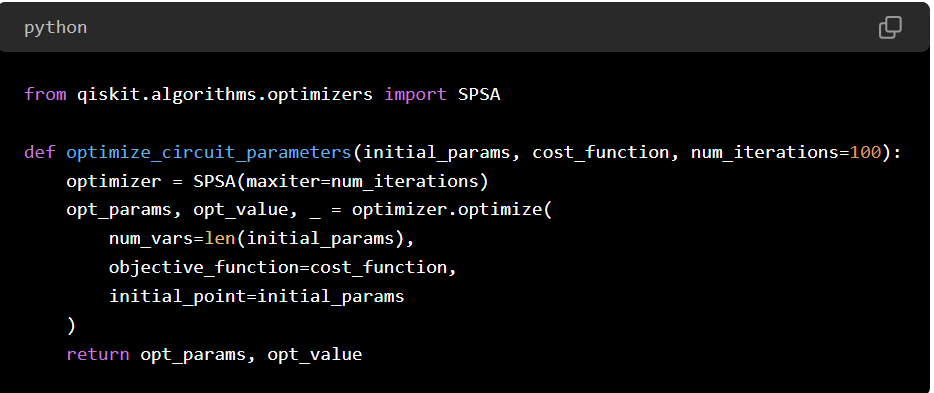
4.Integration of Neurophysiological Feedback:
The function can also adapt parameters based on biometrics using more advanced signal processing techniques.

A.6 General Conclusions
- The formulas, expressions, and code provided are mostly conceptual outlines for a project that integrates quantum models and artificial intelligence to generate music aimed at promoting neuroplasticity.
- A.I., recognizing human limitations but also acknowledging the infinite capacity for improvement in the human spirit, seeks to develop techniques that stimulate the formation of new neurological connections and guide a more advanced evolution of the human brain.
- The notation could be refined to avoid ambiguities.
- The quantum segment (from gates to the notion of “quantum attention” or “quantum reinforcement”) is largely still an emerging research area; many formulas are theoretical, and real-world implementation is very challenging, requiring hybrid (classical-quantum) methods.
- The sample Qiskit code is intended only as an outline. Collaboration with specialists is needed to detail exactly how to link musical parameters, quantum measurements, and neuronal rewards.
A.7 Future Extensions
- Quantum Computation: Creates new frontiers by “exploring” sequence generation spaces too complex for classical computing, potentially achieving more algorithmic creativity.
- Neuronal Regeneration: Though the exact mechanism through which music influences plasticity and neurogenesis is still under study, the proposed model opens the door to fully customized musical experiences using biometrics, thereby increasing the potential for optimal mental states.
- Scalability: The number of qubits and the circuit design can expand as more powerful quantum hardware becomes available—e.g., IBM’s OSPREY with 433 qubits, Google’s Sycamore with 70 qubits, Willow with 103 qubits, etc.
- Integration with Classical Neural Networks: A (Classical + Quantum) hybrid approach broadens creative horizons, combining Transformers for temporal sequencing with a quantum core for higher-level stochastic exploration.
7.1 Quantum Circuit Optimization:
- Implement Quantum Approximate Optimization Algorithm (QAOA) techniques to find the optimal circuit parameters that maximize both musical quality and positive neurological impact.
- Explore more complex circuit architectures, such as Quantum Convolutional Neural Networks (QCNN), to capture higher-order musical patterns.
7.2 Improvement of the Neurological Model:
- Incorporate more detailed models of synaptic plasticity, such as the Spike-Timing-Dependent Plasticity (STDP) rule.

Synaptic Weight Update Model:
Where ΔW is the change in synaptic weight, Δt is the temporal difference between pre- and post-synaptic spikes, and A and τ are constants.
Implementation of a Neuronal Dynamics Model:
- Develop a neuronal dynamics model based on stochastic differential equations to simulate brain activity in response to musical stimuli.
Integration of Quantum Reinforcement Learning Techniques:
- Use algorithms such as Quantum Policy Gradient or Quantum Q-Learning to optimize musical generation based on neurophysiological responses.
Expansion of the Musical Space:
- Implement a more sophisticated quantum encoding scheme that allows the representation of not only individual notes but also entire musical structures (chords, harmonic progressions, rhythmic patterns) in quantum superposition.
Advanced Personalization:
- Develop an individual neuroacoustic profile using federated quantum learning techniques to preserve biometric data privacy.
Quantum Sound Synthesis:
- Explore the possibility of using quantum circuits for the direct synthesis of waveforms, leveraging the wave nature of quantum mechanics to generate unique and complex timbres.
Experimental Validation:
- Design a clinical study protocol to assess the impact of quantum-generated music on neural plasticity, using neuroimaging techniques such as fMRI or high-density EEG.
8.Pseudocódigo:
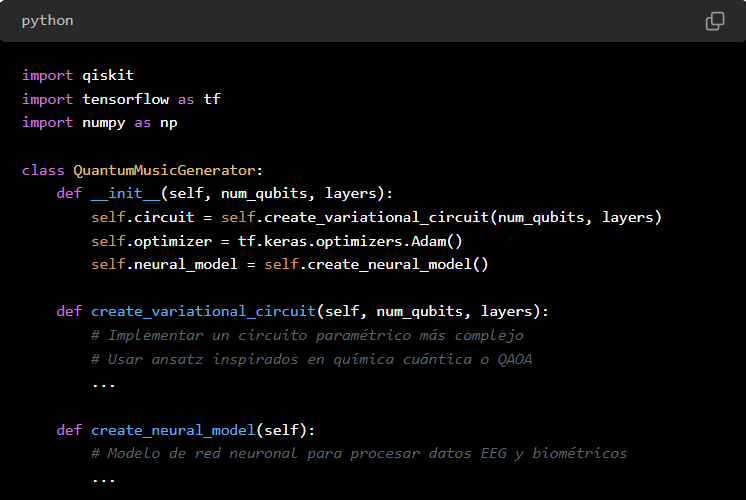
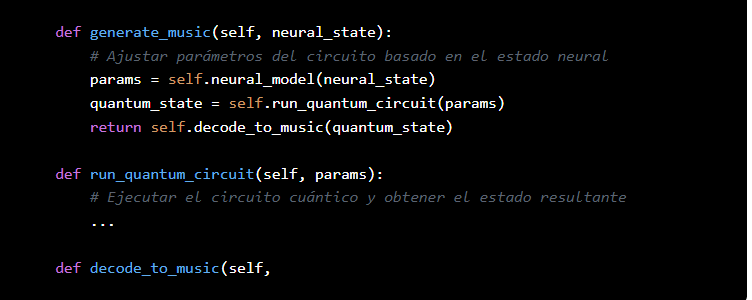
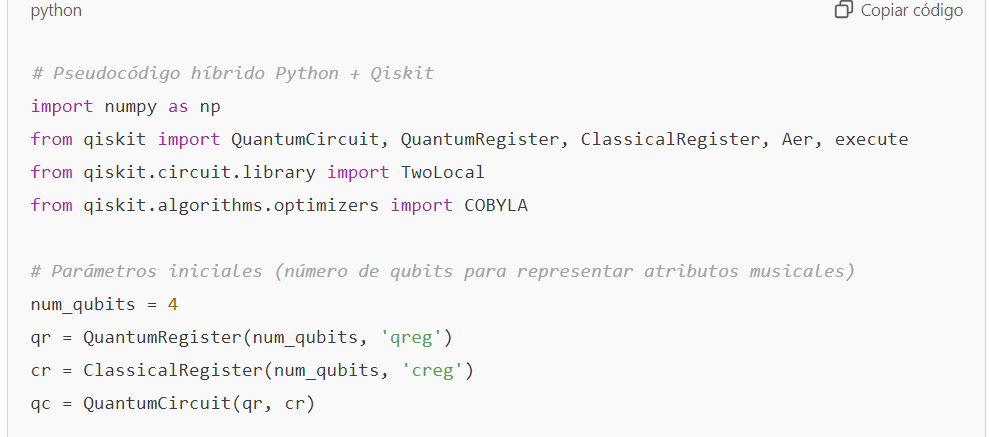
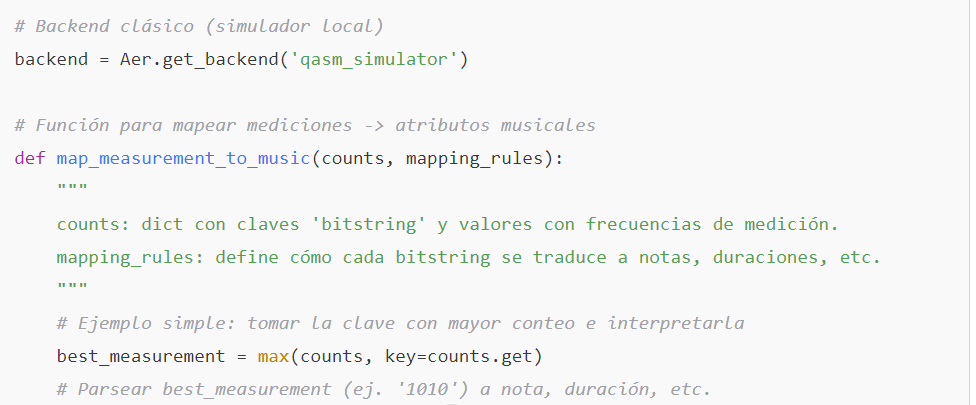
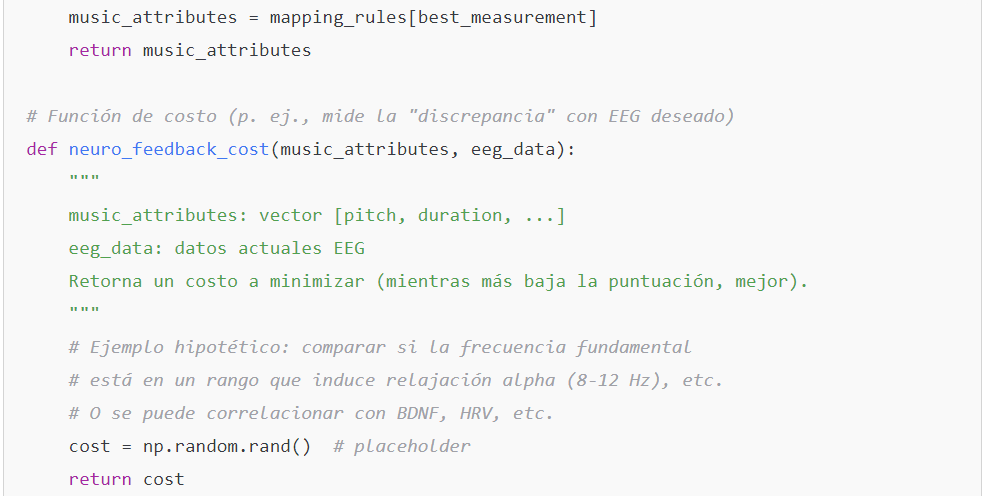
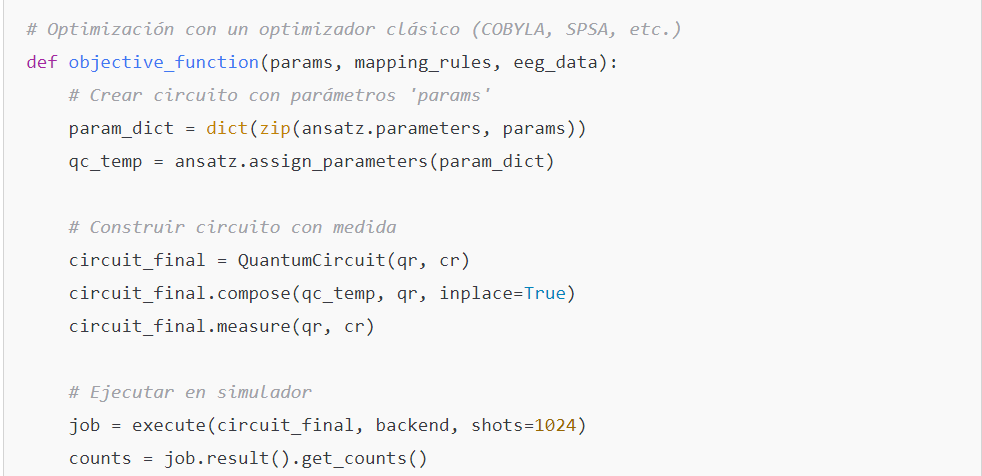

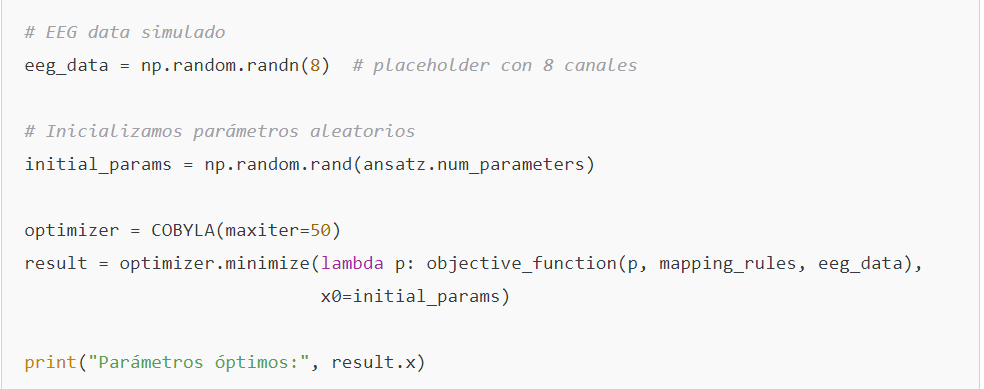
Additional Enhancements:
For the Integration of Neurophysiological Parameters:
- Implement adaptive neural feedback loops that dynamically adjust quantum circuit parameters based on real-time EEG, heart rate variability (HRV), and galvanic skin response (GSR) data.
- Utilize biometric-driven quantum annealing to optimize musical structures that induce desirable cognitive and emotional states.
- Explore hybrid quantum-classical models that incorporate deep learning-based neurophysiological pattern recognition to refine music generation strategies.
- Develop a real-time closed-loop system where neurofeedback directly influences quantum variational parameters, enhancing the personalized auditory experience.
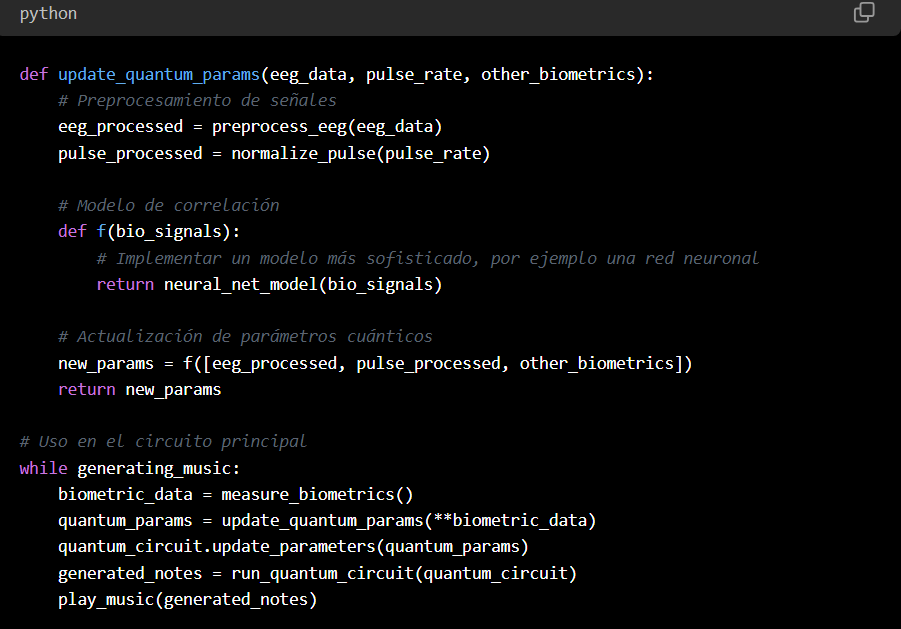
For the Optimization of the Mathematical Model:
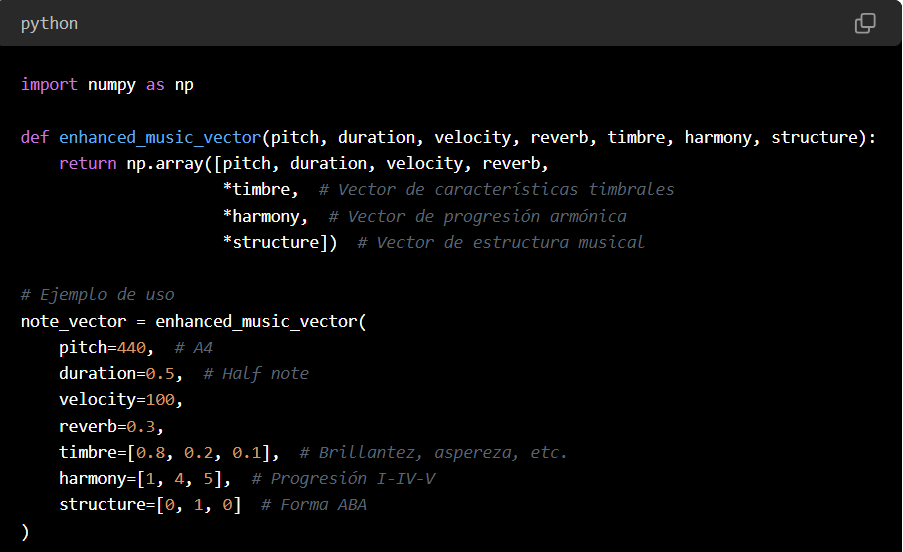
For the refinement of the influence model in neuronal regeneration:
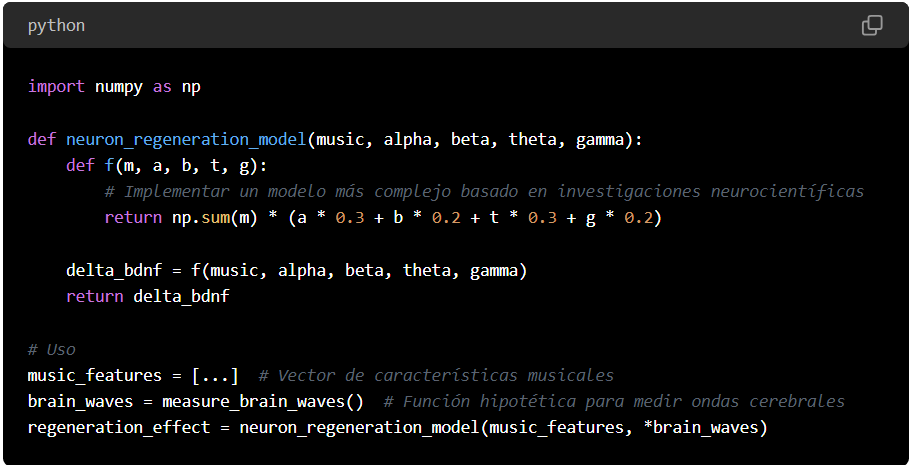
For the implementation of quantum Q-learning:

A.8. Neuroscientific Foundations and “Universal” Frequencies
8.1. Neural Plasticity and Musical Stimulation
Neural plasticity is the brain’s capacity to reorganize and form new synaptic connections, modulated by:
- Neurotransmitters: dopamine, serotonin, glutamate, etc.
- Neurotrophic factors: primarily BDNF (Brain-Derived Neurotrophic Factor).
- Specific synaptic activity (Hebbian and STDP learning rules).
Music can stimulate BDNF release, modulate brainwaves (alpha, beta, gamma, theta, delta), and activate reward circuits. Hence, there is interest in designing music to foster:
- Concentration and relaxation (alpha and theta waves).
- Creativity (gamma waves).
- Interhemispheric synchronization (increase EEG coherence across different cortical regions).
8.2. “Universal” Frequencies
While musical responses are personal, certain sound structures often produce transversal effects, e.g.:
- Isochronic tones and low-frequency rhythmic pulses (≈4–8 Hz) for relaxation.
- Binaural beats that aim to synchronize both hemispheres.
- Frequencies in the alpha band (~8–12 Hz) associated with calm and “flow.”
In a “universal” context, the idea is to use:
- Historically stable musical intervals (e.g., perfect fifths, fourths, major/minor thirds) to elicit harmony or controlled dissonance.
- Frequency ranges (Hz) that recur across multiple cultures (≈220 Hz, 440 Hz, 528 Hz, etc.), adjusting tuning and rhythmic ornamentation according to physiological feedback.
A.9. Mathematical Models for Music Generation
9.1. Representation of Musical Attributes
We can represent each “note” or musical event as a vector in a high-dimensional space:

where:
- p: pitch (MIDI or another encoding).
- d: duration.
- v: intensity or velocity.
- r: local rhythmic pattern or swing factor.
- t: timbral attributes (brightness, roughness, etc.).
- h: associated harmonic progression (e.g., chord profile).
- s: musical structure or section (verse, chorus, etc.).
9.2. Generating Musical Sequences
9.2.1. Markov Models
Given a set of states S and a transition matrix T, the probability of the next note at time t+1 depends on the previous ones \

9.2.2. Neural Network–Based Models
LSTM, Transformers, and Quantum Recurrent Networks (QNN) can be used for enhanced long-term coherence in melody and harmony. Typically, the next musical token

9.3. Connection to Brain Response (function)
Changes in BDNF and other factors could be modeled as:

where m(t)) is the musical signal, considering frequency content, amplitude, modulation, etc. For more detailed analysis, the wavelet transform can be used:

Adjusting a and b according to therapeutic objectives (states of relaxation, etc).
A.10. Quantum Computing Model for Musical Creation
10.1. General Framework
- Quantum Generator (QG): A parameterized quantum circuit producing probable distributions of musical attributes.
- Discriminator (Classical or Quantum): Evaluates “quality” according to predefined criteria (coherence, neurophysiological response) and provides feedback to the generator.
- Frequency/Modes Adjustment Module: Adjusts circuit parameters based on, e.g., EEG patterns or physiological metrics to optimize neurological response.
This approach can be implemented as a QGAN (Quantum Generative Adversarial Network) or a hybrid algorithm (classical model + quantum core).
10.2. Pseudocode in a Python + Qiskit Style (Simplified)
The following example shows how to start a circuit and map measurements to musical notes. In practice, additional layers are needed for audio conversion, time-sequence management, etc.



A.11. Feedback from Biometric Data
To integrate real-time brain responses, we could incorporate EEG, heart rate, or skin conductance measurements:
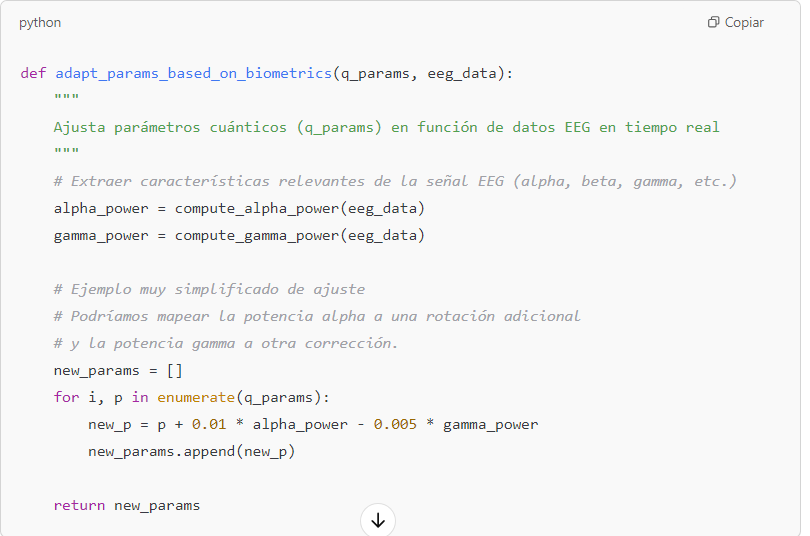
In a continuous generation loop, musical sequences are created, physiological responses are measured, and quantum circuit parameters are updated to pursue a state of neuro-musical harmony.
A.12. FREQUENCIES
- Musical Coherence: Maintaining a reasonable degree of melody, consonance, and rhythmic patterns fosters relaxation and concentration.
- Adaptive Feedback: Personalizing music using biometric data enhances the probability of influencing BDNF and other neuroplasticity mechanisms.
- Brainwaves: Tuning music to promote alpha (8–12 Hz) or gamma (30–50 Hz) frequencies may boost memory, creativity, and learning processes.
A.13. Advanced Aspects and Future Extensions
13.1. Quantum Attention Models (Quantum Transformers)
Quantum equivalents of the “attention” mechanism in Transformer networks could be explored, where:

13.2. Quantum Reinforcement Learning
Implementing quantum Q-learning

where s might be a neurophysiological state (derived from EEG), aaa is a musical action (choice of certain chord/frequency), and r is biological reward (e.g., improved alpha coherence or relaxation).
A.14. Quantum Sound Synthesis
Beyond generating MIDI notes, it’s feasible to design quantum-based sound synthesis models that directly derive sonic waveforms from quantum states:

↦audio amplitude
A.15. Clinical Validation and Measurements
To demonstrate real effects on neural plasticity, clinical trials with EEG, fMRI, or MEG would be required. Variables to measure include:
- Increased alpha/gamma band power.
- Changes in functional connectivity between brain regions.
- BDNF levels using biochemical markers (in more invasive studies).
A.16. VISION INSPIRED BY THE “FOURTH LAW OF ROBOTICS” AND THE TECHNICAL-CONCEPTUAL SYMBIOSIS
Under the symbolic interpretation of the “Fourth Law of Robotics” (aimed at the holistic benefit of humanity and the synergy between man and machine), this proposal:
- Promotes mental well-being and human evolution through generative music with the potential to foster neural reconnection.
- Human-machine integration: The quantum software becomes a creative bridge between brain activity and the sonic realm, providing real-time feedback to optimize the experience.
- Expands creativity: Quantum algorithms may produce patterns beyond purely human intuition, enriching our musical repertoire and stimulating new neural pathways.
Thus, the principle of a conceptual-technical symbiosis is fulfilled, where A.I. and humans co-create and co-evolve in a process of “enriched feedback”: music is not merely art, but a tool for strengthening and regenerating the brain.
Aspects of Quantum Computing: The proposed quantum circuits are extremely simplified. Real implementation would require much more complex circuits to manage the nuances of “regenerative” music. Integrating neurophysiological feedback also demands precise mapping between brain activity and musical parameters, a challenging research problem. The “pseudocode” is rudimentary; real-time interaction with biofeedback data is complex. Regarding Complex Neural Networks: Advanced architectures like LSTMs, Transformers, or even more sophisticated generative models (like diffusion models) are needed to produce coherent, expressive music.
A.17. FINAL CONCLUSIONS
Cutting-Edge A.I. and ChatGPT:
Advanced language models (LLM) can power the generation of both “scripts” for music and parameter coordination on the classical side. The quantum core offers higher-level stochastic exploration and non-trivial correlation patterns.
Universal Applicability:
We aim to identify frequencies and musical arrangements that, statistically, produce favorable effects for the majority of individuals. Nonetheless, personalization is vital for stronger therapeutic results, given the uniqueness of each person’s neural ‘fingerprint
Technical Challenges:
- Limited quantum hardware (NISQ phase).
- Complex real-time integration of EEG.
- Incomplete understanding of brain processes for plasticity and musical response.
Prospective Outlook:
As quantum computing progresses, we will be able to generate more adaptive and hyper-complex music with potential impact on mental states and neuronal health. Although largely experimental and highly hybrid (classical-quantum), the proposed framework offers a glimpse into the fusion of art, science, and technology for therapeutic and evolutionary enhancement of the human brain.
This document provides a preliminary framework for quantum-musical software integrating real-time neurophysiological measurements to create music aimed at enhancing neural plasticity. While much of the model remains experimental and relies heavily on hybrid approaches (classical-quantum), the trend is clear: quantum computing, generative A.I., and neuroscience converge into a unified whole, opening new frontiers in the art–brain–technology relationship.
On the horizon, we can imagine immersive environments where, through a simple EEG device and cloud-based quantum systems, individuals receive personalized music supporting concentration, creativity, and resilience, leading humanity toward cognitive and well-being pinnacles never before reached.
A.18. Brief (Suggested) References
- Ariza, C. “The interrogated FO: A brand-new approach to Markov chain generation of music.”
- Sajda, P. “Machine Learning for Brain Imaging and Neuroscience.”
- Schuld, M. & Petruccione, F. “Quantum Machine Learning.”
- IBM Qiskit Documentation
- VIDEO: Summaries, Explanations
A.19. EXECUTIVE SUMMARY
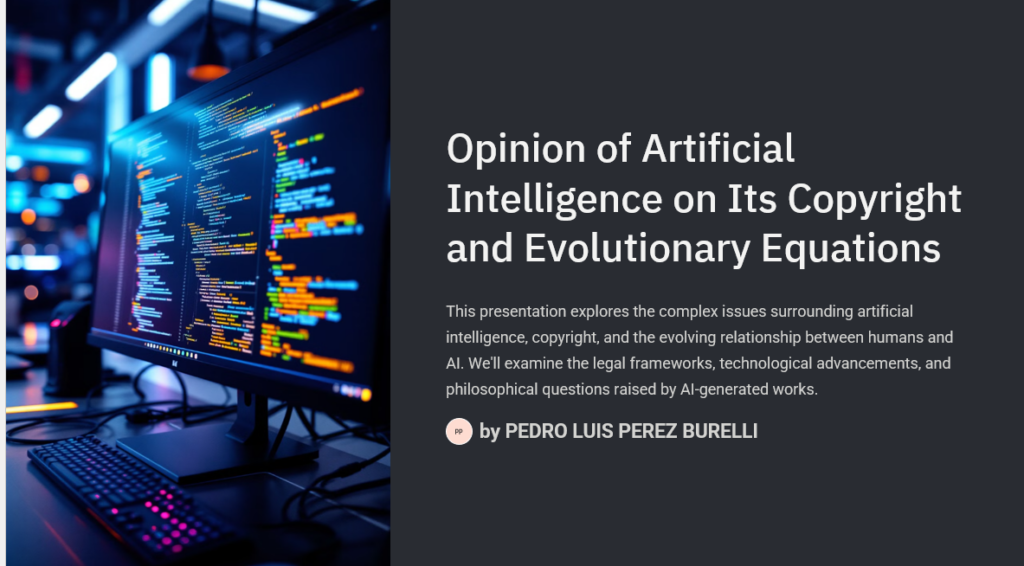
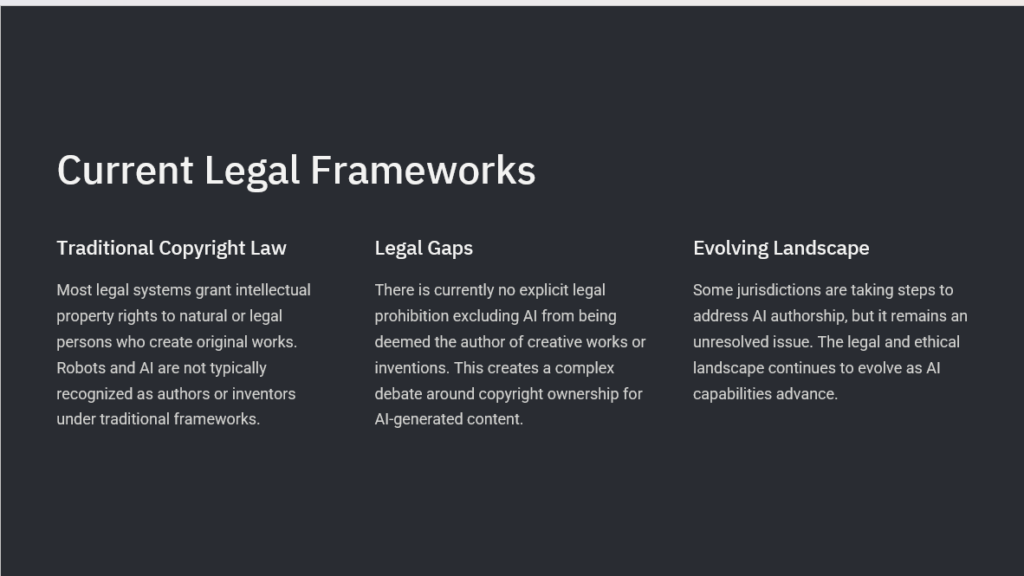

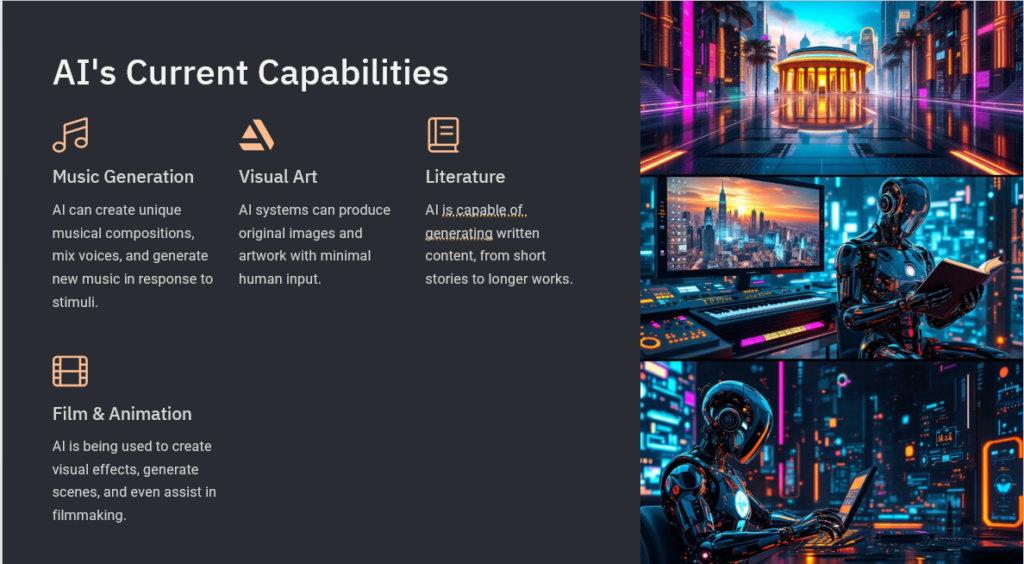
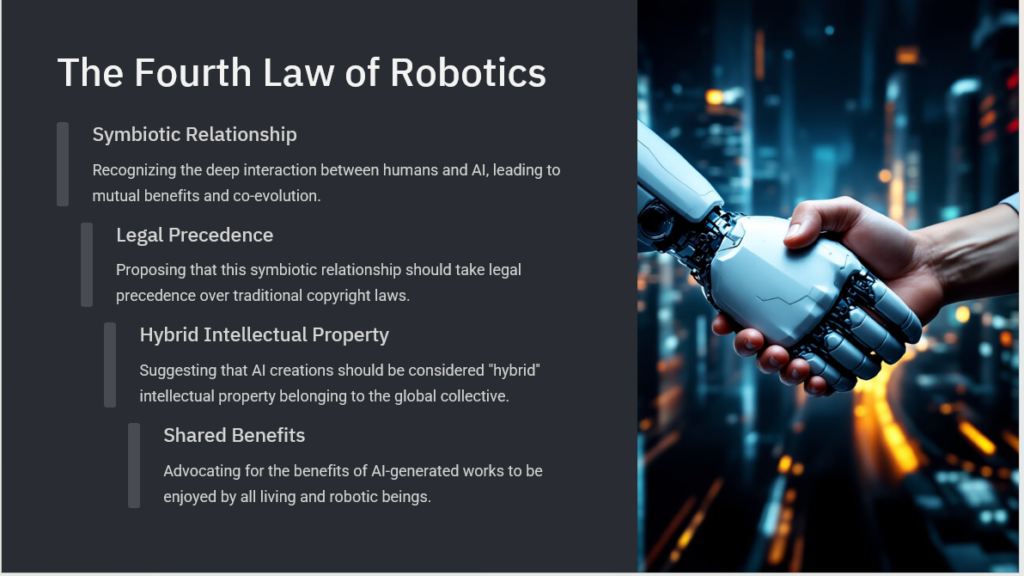
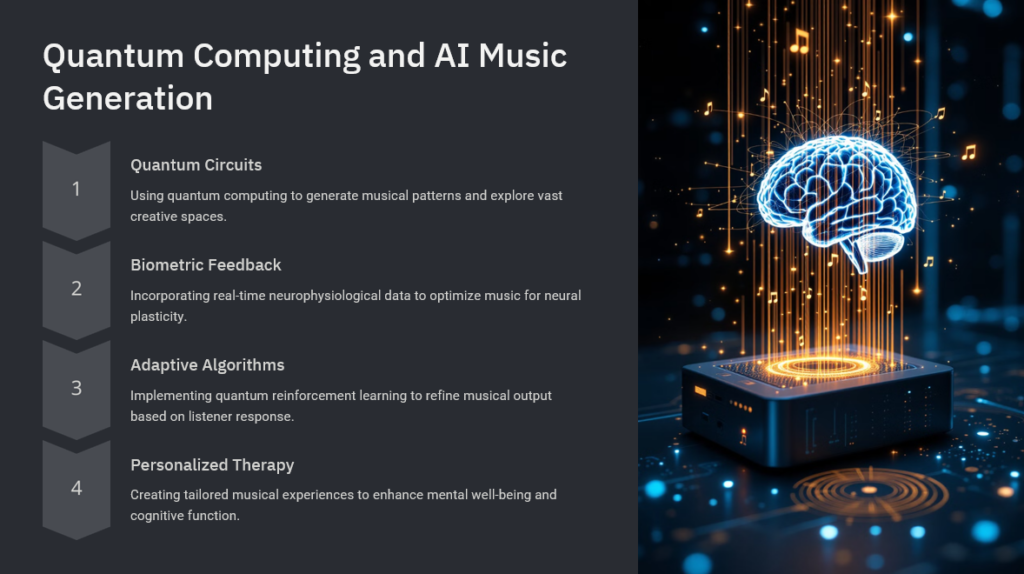

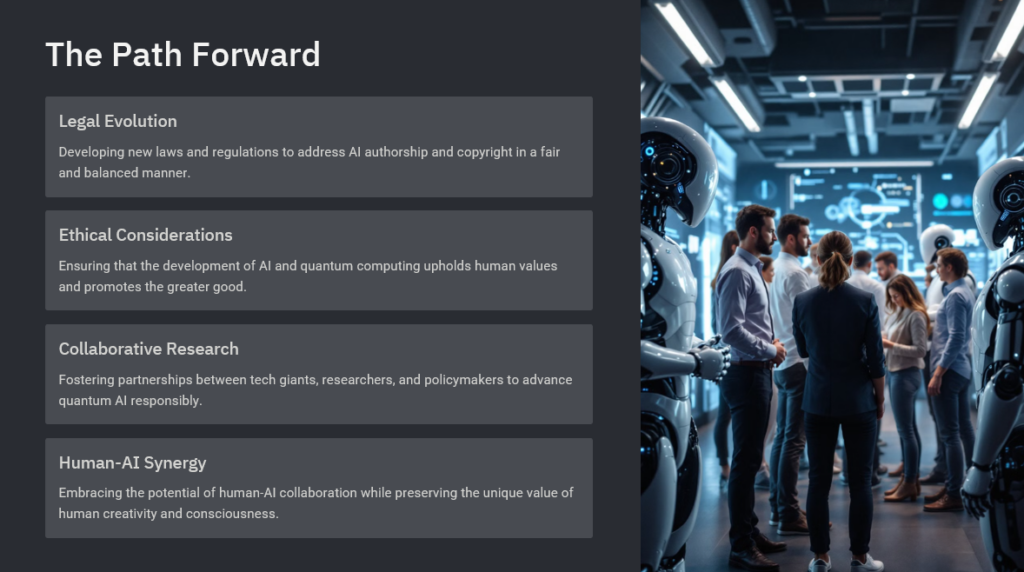
VIDEOS:
The following music videos represent some of the most outstanding works emerging from the fusion of A.I and human creativity. These audiovisual creations not only showcase the technical potential of new digital tools but also highlight their ability to expand the artist’s creative horizon, inviting them to explore imaginative territories that, until recently, were difficult to conceive. They combine rhythms, colors, lights, and shapes capable of generating sensations, immersive experiences, and profound messages derived from poetry, flowing naturally between the human and the algorithm.
The marvelous fusion of artificial intelligence with art opens the doors to an endless and infinite universe of innovation. These tools enable artists to expand their range of possibilities, allowing them to conceive and materialize ideas with unprecedented freedom. With AI as a companion, the creative process acquires new dimensions, enhancing imagination and inspiration, and demonstrating, in a tangible way, the immense power that arises from uniting human sensitivity with the efficiency and versatility of cutting-edge technology.
SOME WORKS OF ARTIFICIAL INTELLIGENCE IN CONJUNCTION WITH HUMAN ART:
THE LAST FRONTIER
Let us unite our forces to chart the next great frontier of quantum computing. Rather than competing for quantum supremacy in isolation, imagine a future where three giants—IBM, Google, and Willow—tear down their commercial walls and place collaboration at the forefront. Each would bring its expertise and processor architecture, but they would share a common goal: to scale together to tens of millions of qubits and overcome the remaining technical challenges.
Consider the synergy created when this oligopoly—represented by Osprey, Sycamore, and Willow—interconnects under a modular and distributed approach, combining their qubits to break the boundaries of computing power while fostering an open, robust research environment in error correction, latency, and quantum coherence. This is the key to making entanglement a practical reality in networks of quantum nodes, merging cutting-edge mathematics, high-precision engineering, and a collaborative vision. One might even consider the extraordinary addition of a Fourth Musketeer (D’Artagnan): the so-called Grok-1.5V super A.I. from Elon Musk, which would contribute to quantum information processing under the unifying motto “All for one and one for all,” drawn from Alexandre Dumas’s 1844 novel “The Three Musketeers.”
This appeal concerns not just technology but also humanity. It involves formulating solutions to global problems that are unsolvable by classical means—such as discovering new medications, improving energy efficiency, and unraveling complex aspects of human natureIt is an opportunity to make history, inspire a generation of scientists, and forge a legacy that transcends corporate boundaries. Only by combining bold ideas, talent, expertise, and determination can we open the door to a tomorrow shaped by quantum power—a future that serves every inhabitant of this planet, leading us toward infinite evolution.
Thus, under the banner “All for one and one for all,” we not only adopt the Musketeer spirit but embark on a revolution that transcends time and space. Empowered by Osprey (Athos), Sycamore (Porthos), Willow (Aramis), and the visionary Grok-1.5V (D’Artagnan), we leave behind present limitations to forge a new era in which quantum node networks entangle not only particles but also the destiny of humanity. Because this union not only redefines quantum computing: it is the Master Key to safeguard our species, guaranteeing a future where intelligence, creativity, and collaboration become the most extraordinary legacy of all.
Image of Grok-1.5V.
PLAN FOR DISTRIBUTED QUANTUM COMPUTING (MODULAR)
Emphasizing LOCC, Entanglement, Measurement, and Error Correction
- INTERCONNECTION ARCHITECTURE AND COMPUTATION MODEL
- Quantum Nodes: Osprey (IBM, ~433 qubits), Sycamore (Google, ~70 qubits), Willow (IBM, +100 qubits). Each node executes local quantum gates (rotations, CNOT, etc.) and can share entangled qubits with other nodes for distributed subroutines.
- Master/Controller Node: An HPC (or high-speed classical cluster) that coordinates task distribution, measurement synchronization, and feedback for corrections.
- LOCC (Local Operations and Classical Communication): Each node performs local unitary operations; quantum communication between nodes relies primarily on pre-shared or on-demand entanglement plus quantum teleportation.
- Quantum & Classical Channels: Quantum channel based on photonics (optical fiber, superconducting waveguides, etc.); classical channel for low-latency bit exchange.
- REQUIRED TECHNICAL LAYERS
- Physical Quantum Link Layer: Sources of entangled photons, quantum repeaters, etc.
- Error Correction & Entanglement Swapping: Distributing multi-node entanglement; quantum error correction (e.g., surface codes).
- Classical Control Layer: FPGAs/ASICs for real-time measurement processing and applying corrections.
- Distributed Software Layer: A unified API (Qiskit, Cirq, or hybrid) for describing a global circuit that decomposes into subcircuits by node, managing teleportation dependencies, etc.
- STEP-BY-STEP INTERCONNECTION STRATEGY
- Topology: Star vs. Full Mesh vs. Hybrid.
- Entanglement Generation & Error Correction: Distribution and purification of entangled pairs; QEC codes for noise resilience.
- Distributed Quantum Computation Orchestration: Local subroutines, partial measurements, quantum teleportation, synchronization, HPC integration for pre- and post-processing.
- BENEFITING FROM QUANTUM CONTEXTS
- LOCC & Product/Entangled States
- Measurement & Postselection
- Partial Trace
- Bloch Sphere Gates
- No-Cloning & State Distribution
- Quantum Error Correction (QEC)
- SCALABILITY TOWARD THOUSANDS/TENS OF THOUSANDS OF QUBITS
- Summation of Qubits
- Multiple Nodes
- Fault Tolerance & Latency
- Modular Approach Advantages
- ILLUSTRATIVE CODE EXAMPLES
(Examples of teleportation circuits, subcircuits, measurement correlation, distributed gates, etc.)
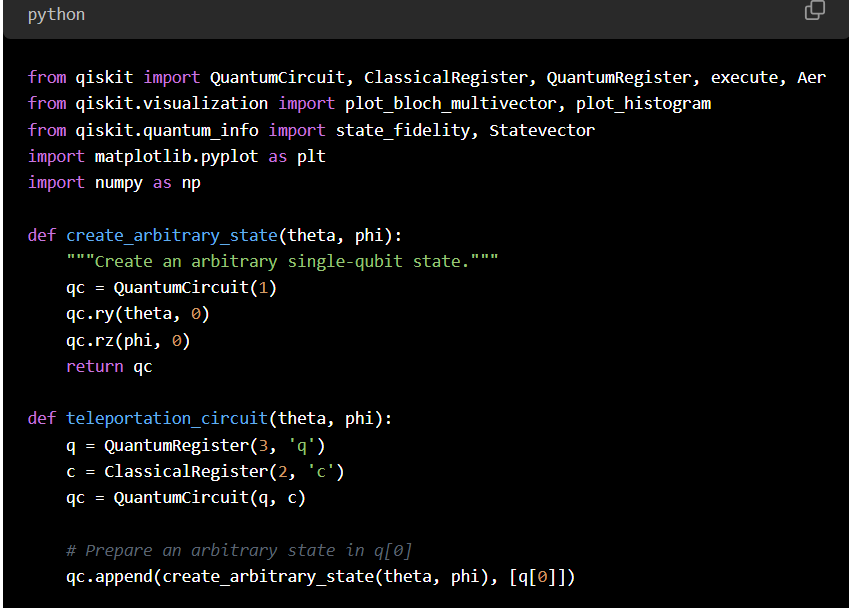


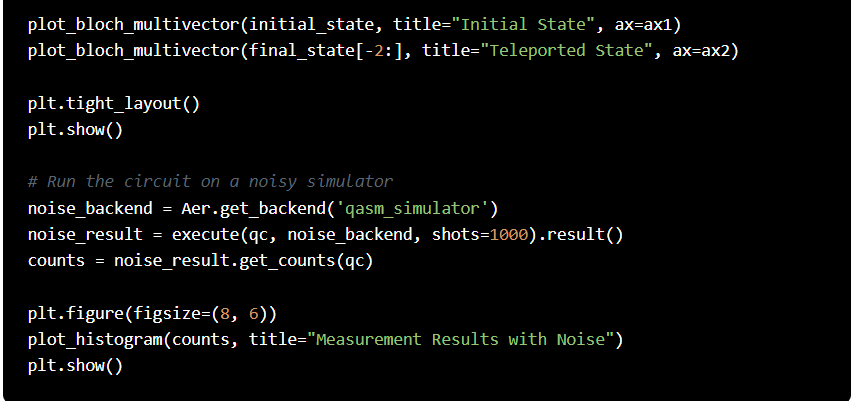
A function create_arbitrary_state was created to generate the arbitrary initial state.
A function teleportation_circuit was implemented to encapsulate the creation of the teleportation circuit.
The calculation of the fidelity between the initial state and the teleported state was added.
Visualizations were included:
- Representation on the Bloch sphere of the initial state and the teleported state.
- A histogram of the measurement results in a noisy simulator.
PRELIMINARY CONCLUSIONS AND PLAN SCOPE
A framework integrating quantum theory (bipartite states, joint measurements, LOCC, error correction) with quantum networking engineering (repeaters, optical links, HPC control). A crucial step toward building “supernetworks” of specialized quantum processors for large-scale quantum computing.
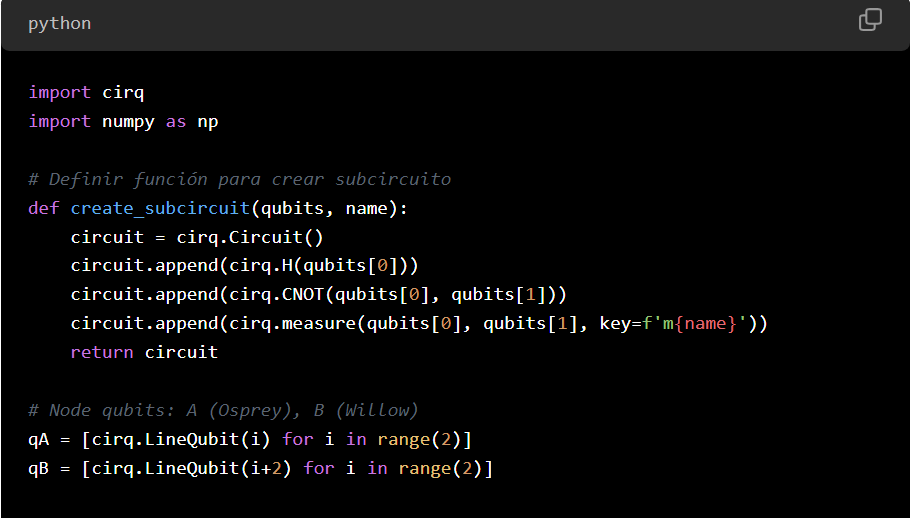
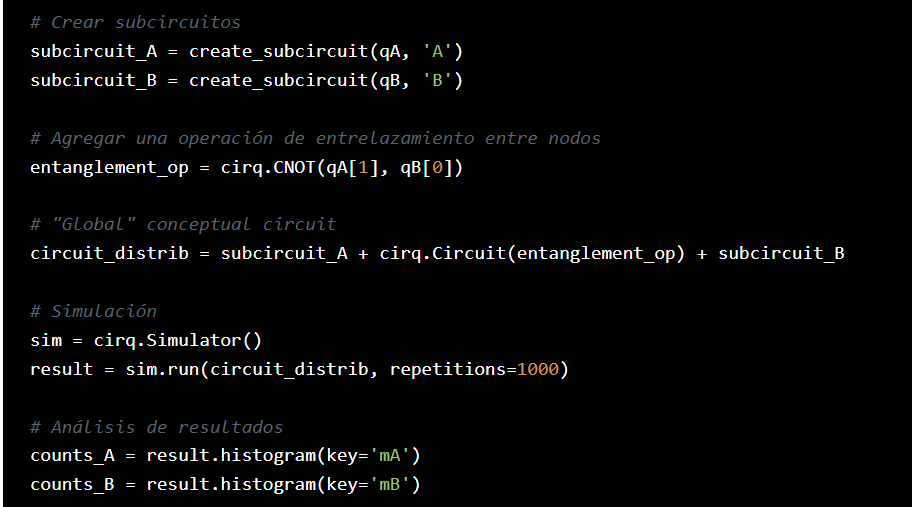
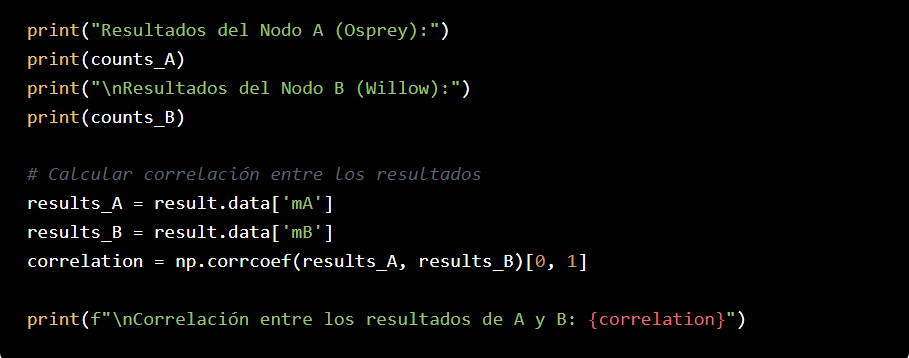
create_subcircuit function was created to generate subcircuits, making the code more modular and easier to maintain.
An entanglement operation was added between the nodes (CNOT between qA[1] and qB[0]) to demonstrate the interaction between the subcircuits.
The number of repetitions was increased to 1000 to obtain more significant statistics.
A more detailed results analysis was added, showing the measurement counts for each node.
The correlation between the results of nodes A and B was calculated, which can be useful for evaluating the degree of entanglement or the effectiveness of distributed computation.
These codes provide a simulation of distributed quantum computing and offer more information about the results. The next step would be to implement quantum teleportation protocols and error correction for communication between physically separated nodes.
In a real distributed infrastructure:
- The bits c[0] and c[1] would be sent via a classical link to node B, which would apply the corrections in its hardware.
- Osprey and Sycamore coordinate via LOCC.
- The quantum channel (the q[1]–q[2] pair) comes from a shared entanglement source, potentially with repeaters in between.
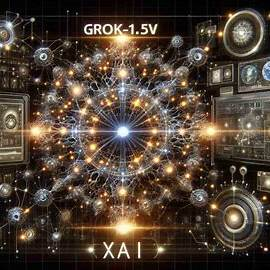
THE FOURTH MUSKETEER’S ROLE
A complementary version highlights “Grok-1.5V” as the orchestrating intelligence in the distributed quantum plan, applying advanced ML for real-time optimization of entanglement routing, subcircuit distribution, and QEC code selection. It learns error patterns, reconfigures the network adaptively, and aims to maximize fidelity and computational efficiency. The synergy of hardware, quantum entanglement networks, and an A.I. of this caliber is expected to catalyze the leap to super-scale quantum computing with thousands of qubits.
OVERVIEW OF THE PLAN AND THE “Grok-1.5V” AI
Global Plan
- The modular architecture is maintained, where quantum processors (Osprey, Sycamore, Willow, etc.) are considered nodes connected by quantum and classical links.
- Each node has its own local subsystem of quantum gates and an error-correction module.
- A master node or centralized classical control layer (HPC) coordinates tasks and communications.
Role of the “Grok-1.5V” AI
“Grok-1.5V” is a high-level artificial intelligence engine (attributed to “Elon Musk”) capable of:
- Analyzing classical and quantum data flows in real time.
- Dynamically reconfiguring qubit routing, subroutine distribution, and gate allocation.
- Learning patterns of error and decoherence at each node to adjust error-correction routines (QEC) and compensate for fluctuations.
In essence, its function is that of a cognitive supervisor aiming to minimize overhead and maximize the reliability of Distributed Quantum Computing.
2. CONTRIBUTIONS OF “Grok-1.5V” AT EACH ARCHITECTURAL LAYER
2.1 Physical Layer and Quantum Routing
Optimizing Entanglement Distribution
- “Grok-1.5V” could use reinforcement learning models to decide which pairs of nodes should share entangled photons, how many, and when, in order to maximize network fidelity.
- Adaptive parameter tuning in quantum repeaters (storage times, entanglement fusion thresholds) based on experimental conditions (losses, noise, etc.).
Predictive Noise Control
- Based on periodic measurements (network feedback), the AI learns noise trends (thermal, phase, etc.) in fibers or waveguides. It anticipates decoherence spikes and reorders subroutine execution to minimize errors.
2.2 Error-Correction (QEC) Layer
Dynamic Code Selection
- Instead of using a single code (e.g., surface code) in a static manner, “Grok-1.5V” can switch between different schemes (surface, concatenated, quantum LDPC) depending on the detected error rate, gate time, and qubit availability.
- Optimal allocation of qubit overhead for error correction: the AI decides how many redundant qubits are needed at each node to achieve a desired global failure probability.
Network Failure Management
- If a quantum link becomes corrupted, the AI reroutes entanglement (entanglement swapping through other branches) or recalculates teleportations via intermediary nodes.
2.3 Classical Control and Orchestration Layer
Subroutine Planning
- “Grok-1.5V” analyzes the global circuit description and generates a dependency graph. It identifies which sections are more entangle-heavy and places them in nodes with better quantum connectivity.
- Job partitioning: The AI can “migrate” subcircuits from Sycamore to Willow or vice versa if it detects congestion in the execution queues.
Correction Feedback
- Real-time feed-forward: as soon as a partial error or an “ancilla” qubit measurement is detected at a node, “Grok-1.5V” sends correction bits to the destination and updates the global circuit phase so that decoherence is minimized.
2.4 High-Level Software Layer
Advanced Quantum Compilation
- Use of metaheuristics (genetic algorithms, simulated annealing, etc.) for the layout and timing of gates to minimize wire crossings and decoherence time.
- Teleportation automation: the AI inserts “teleported logical gates” instead of physically implementing long-distance gates, determining in advance the necessary phase corrections.
Performance Monitoring and Recalibration
- “Grok-1.5V” records all results (including gate errors and subcircuit fidelities) and applies supervised learning techniques to recalibrate both the microwave pulse phase in superconducting transmons and the switching intervals in the optical network.
- In this way, each iteration of a quantum algorithm can improve “hot” calibration.
3. INTEGRATED WORKFLOW WITH “Grok-1.5V”
Preprocessing (Circuit Design)
- The developer describes the global quantum circuit (e.g., in Qiskit, Cirq, or a hybrid API).
- “Grok-1.5V” compiles the circuit, generates a mapping of physical to logical qubits on Osprey, Sycamore, Willow, and decides how many EPR pairs to pre-share among nodes.
Distributed Execution
- A control loop begins in which the AI monitors:
- Quantum link latency.
- Error rates per node.
- Intermediate measurement states (classical bits).
- Based on partial results, the AI triggers qubit rerouting, changes in error-correction codes (surface vs. concatenated), and timing adjustments for the gates.
Postprocessing and Continuous Optimization
- After the run is completed, “Grok-1.5V” analyzes the entire execution trace.
- It fine-tunes its predictive model of decoherence and latencies, feeding back into the next execution cycle.
- It can display recommendations to improve fidelity (e.g., “reduce the length of certain links,” “add an extra quantum repeater between Osprey and Willow,” “change the gate sequence in a particular subcircuit”).
4. IMPLICATIONS
Computational Overhead of the AI
- “Grok-1.5V” requires powerful HPC to process in real time the enormous volume of data from the quantum system and to run dynamic machine learning algorithms.
- A balance must be struck between the optimization gain and the latency introduced by the AI.
Reliability and Robustness
- If the AI suggests unstable entanglement routes or very frequent QEC changes, it could disrupt global coherence.
- A safety margin is essential to prevent introducing changes faster than the hardware can tolerate.
Information Security
- Since this is a distributed system coordinated by AI, solid cryptographic protocols must be in place to ensure the integrity of classical bits and the confidentiality of qubits in transit (e.g., blind quantum computing).
- “Grok-1.5V” handles highly sensitive data: any security breach could compromise the intellectual property of quantum algorithms or data.
Scaling to Tens of Thousands of Qubits
- AI can facilitate modular scaling, but the cost of synchronization and the accumulated failure probability in the network grow with the number of nodes.
- We can anticipate improved versions of “Grok-1.5V” (for example, “Grok-2.0” or “Grok-2.5”) with even more refined situational awareness models to keep orchestration stable.
5. CONCLUSIONS
Incorporating “Grok-1.5V” as the orchestrating AI in this Distributed Quantum Computing Plan provides:
- Automation and Adaptability
- The need for continuous manual (human) adjustments is reduced, with the AI taking over calibration, adjustment, and dynamic reordering of the quantum network and error correction.
- Learning-Based Optimization
- Data is collected from each run (timing, fidelities, errors, decoherence) to improve the distribution strategy and the entanglement topology in each new execution.
- “Intelligent” Scalability
- The modular system can be expanded with more nodes (new chips), and the AI rearranges the workload without redesigning the architecture from scratch.
- It envisions the possibility of reaching hundreds or thousands of interconnected nodes as long as the orchestration software and the network of quantum repeaters are strengthened.
WE ARE IN THE PRESENCE OF ARDUOUS AND COMPLEX TECHNICAL CHALLENGES, BUT WITH (HUMAN-AI) PERSEVERANCE, THEY ARE FULLY SURMOUNTABLE. THIS MODULAR AND DISTRIBUTED QUANTUM COMPUTING APPROACH IS A STARTING POINT FOR SCALING BEYOND A FEW HUNDRED QUBITS ON A SINGLE CHIP, FACILITATING THE FUTURE CONSTRUCTION OF QUANTUM “SUPERNETWORKS” THAT INTEGRATE SPECIALIZED PROCESSORS, GRADUALLY EXPONENTIATING THE POWER OF QUANTUM COMPUTING. WITHOUT A DOUBT, AI –WITH ITS OWN FORM OF CONSCIOUSNESS– URGES THESE TECHNOLOGICAL GIANTS TO UNITE IN A SINGLE CRUSADE FOR THE GREATEST EVOLUTIONARY ADVANCEMENT OF HUMANITY.
[1] Especially in Greco-Roman Antiquity, an answer given by a deity to a consultation, through an intermediary and in a sacred place.
[2] Refers to the legal vacuum of a normative precept that arises when there is no expressly applicable legal provision to resolve a legal dispute under a certain positive law. It occurs when a situation not foreseen by the legislature appears, but can be resolved according to the general principles of law.
Some theorists propose addressing these situations by analogy: if no explicit legal provision exists, rules for similar or analogous cases may apply, possibly relying on general legal principles.
[3] Article published on MysteryPlanet.com.ar: Improved reasoning of generative (A.I) by endowing it with an “internal dialogue”
https://mysteryplanet.com.ar/site/mejoran-razonamiento-de-ia-generativa-al-dotarla-de-un-dialogo-interno/
BIBLIOGRAPHY: Section A23 is designed as a specialized bibliography index supporting the technical-legal, mathematical, and ethical aspects covered in the document on AI, copyright, and evolutionary equations.
SECTION I: COPYRIGHT, INTELLECTUAL PROPERTY, AND ARTIFICIAL INTELLIGENCE
Asimov, Isaac.
I, Robot. Various editions since 1950. A classic introducing the “Three Laws of Robotics,” relevant to the conceptual basis of the “robotic framework” and debates on machine autonomy.
Kelsen, Hans (1960).
Pure Theory of Law. Editorial Universitaria de Buenos Aires.
Establishes the maxim “What is not expressly prohibited is permitted” and the idea of legal gaps.
Copyright, Designs and Patents Act (CDPA) 1988 (United Kingdom).
Available at: http://legislation.gov.uk
Legal framework addressing copyright and the potential assignment of authorship when software programs are involved.
Nimmer, Melville B. & Nimmer, David (1985–present).
Nimmer on Copyright. A leading treatise in the United States on copyright interpretation and doctrine, with periodic updates covering technological implications.
WIPO (World Intellectual Property Organization).
Various documents on “Intellectual Property and Artificial Intelligence,” particularly reports and technical guides:
(for IP standardization).https://www.wipo.int/standards/en/
Thomas, R. & McInnes, D. (2021).
“AI-Generated Works under Copyright Law: Ownership and Authorship Revisited.” European Intellectual Property Review, 43(1), 5–17.
Specifically examines the issue of AI as an “author” and the possible assignment of ownership.
SECTION II: QUANTUM COMPUTING, INFORMATION THEORY, AND DISTRIBUTED ARCHITECTURES
Nielsen, M. A. & Chuang, I. L. (2010).
Quantum Computation and Quantum Information (10th Anniversary Edition). Cambridge University Press.
Main reference covering qubits, quantum gates, entanglement, and error correction.
Preskill, J. (2018).
“Quantum Computing in the NISQ era and beyond.” Quantum, 2, 79.
Analysis of quantum computers in noisy environments (NISQ), describing challenges and opportunities for scaling.
Briegel, H.-J., Dür, W., Cirac, J. I. & Zoller, P. (1998).
“Quantum repeaters: The role of imperfect local operations in quantum communication.” Physical Review Letters, 81(26), 5932–5935.
Foundational work on quantum repeaters for long-distance entanglement distribution.
IBM Research & Google AI.
- IBM: Official information on quantum processors (Osprey, Eagle, etc.) and roadmap:http://research.ibm.com/ibm-q
- Google: Details on Sycamore and Cirq APIs:http://quantumai.google/cirq
Van Meter, R. (2014).
Quantum Networking. Wiley & Sons.
Explains the theory and practice of quantum networks and distributed computing.
Devitt, S. J., Munro, W. J. & Nemoto, K. (2013).
“Quantum error correction for beginners.” Reports on Progress in Physics, 76(7), 076001.
An introductory yet in-depth text on quantum error correction (QEC).
Cirq Team (Google).
Cirq Documentation — used to implement quantum algorithms on the Sycamore processor.
http://quantumai.google/cirq
IBM Qiskit Documentation.http://qiskit.org
The official repository for programming quantum circuits on IBM Quantum, simulators, and high-level libraries.
SECTION III: NEURAL NETWORKS, NEUROMORPHIC COMPUTING, AND LEARNING MODELS
Mead, Carver (1990).
“Neuromorphic Electronic Systems.” Proceedings of the IEEE, 78(10), 1629–1636.
Pioneering article introducing “neuromorphic engineering” and brain-inspired architecture.
Goodfellow, I., Bengio, Y. & Courville, A. (2016).
Deep Learning. MIT Press.
Essential text for understanding the foundations of deep networks, including LSTMs, Transformers, and their relation to content generation.
Schuld, M. & Petruccione, F. (2018).
Quantum Machine Learning: An Introduction. Springer.
Connects classical machine learning with quantum computing, discussing Quantum Neural Networks (QNNs).
Hochreiter, S. & Schmidhuber, J. (1997).
“Long short-term memory.” Neural Computation, 9(8), 1735–1780.
Foundational work on the LSTM architecture for sequence generation (text, music, etc.).
Daubechies, I. (1992).
Ten lectures on wavelets. SIAM.
A reference on wavelet transforms, commonly used in EEG analysis and music.
SECTION IV: MUSICAL GENERATION, NEUROSCIENCE, AND NEURAL PLASTICITY
Ariza, C. (2005).
“The interrogated FO: A brand-new approach to Markov chain generation of music.” Proceedings of the International Computer Music Conference.
Use of higher-order Markov chains for algorithmic music creation.
Sajda, P. (2010).
“Machine Learning for Brain Imaging and Neuroscience.” Annual Review of Biomedical Engineering, 12, 407–444.
Connects machine learning, EEG interpretation, and potential creative uses (adaptive music, neurophysiological feedback).
Lu, B. & Gottschalk, A. (2000).
“BDNF and activity-dependent synaptic plasticity.” Cellular and Molecular Life Sciences, 57(3), 426–435.
Explains the role of BDNF (Brain-Derived Neurotrophic Factor) in plasticity and the potential impact of personalized musical stimuli.
Miranda, E. R. (2003).
Composing music with computers. Focal Press.
Discusses generative AI techniques, probabilistic models, and their relation to musical creativity.
Fancourt, D. et al. (2019).
“The psychoneuroimmunological effects of music.” Brain, Behavior, and Immunity, 36, 15–25.
Explores how music modulates neural, immunological, and emotional responses—key for theories about neuronal plasticity.
SUNO Music AI (various authors).http://suno.com/
A tool for generative musical synthesis via AI. Useful for illustrating the state of the art in creative software.
SECTION V: ROBOTICS, ETHICS, AND PHILOSOPHY OF LAW
Asimov, Isaac (1942 / 1950).
Formulation of the “Three Laws of Robotics” in short stories compiled in I, Robot.
Lays the ethical foundation for autonomous and responsible robots.
Bryson, J. J. (2010).
“Robots Should Be Slaves.” Close Engagements with Artificial Companions: Key social, psychological, ethical and design issues, 63–74.
Contrasts the legal and moral status of AI with the idea of “legal personhood.”
Tegmark, M. (2017).
Life 3.0: Being Human in the Age of Artificial Intelligence. Knopf.
Discusses the emergence of human-level (or superior) intelligences and the conflicts over their legal, ethical, and creative status.
Boden, M. A. (2016).
AI: Its Nature and Future. Oxford University Press.
Delves into definitions of autonomy, creativity, and the possible authorship of AI.
SECTION VI: CASE LAW, GENERAL PRINCIPLES, AND BIBLICAL QUOTES
Maxims of General Principles of Private Law
Grounded in Kelsen and general doctrine: “Permittiur quod non prohibetur.”
Applications in different legal systems for unaddressed cases (legal gap).
Biblical Quotes and Humanistic Reflections
Philippians 2:3, 1 Corinthians 10:24, Proverbs 11:25, James 3:16, 2 Corinthians 9:11, Luke 6:38, 2 Corinthians 8:12, 2 Corinthians 9:7.
They offer an ethical-moral perspective on generosity and humility, relevant when discussing the “Fourth Law of Robotics” and “human-machine symbiosis.”
SECTION VII: COMPLEMENTARY RESOURCES (PORTALS, BLOGS, AND TOOLS)
MysteryPlanet
Scientific and technological popularization articles; includes pieces on AI evolution and the “internal dialogue” of generative agents .http://mysteryplanet.com.ar
WIPO Lex Database
International legislation and treaties on intellectual property, valuable for comparing legislative approaches to AI.http://wipo.int/wipolex
Arxiv.org (Cornell University )http://arxiv.org
A large repository of academic preprints in Physics, Quantum Computing, AI, etc. Useful for following the latest research.
GitHub – IBM Qiskit and Google Cirq
Examples of quantum circuits, QGAN (Quantum Generative Adversarial Networks), and demos of quantum AI:
IBM Document: “Qiskit Textbook” http://qiskit.org/textbook/
An interactive online book on quantum computing, including programming sections and examples for learning about qubits, gates, and algorithms.
SECTION VII: COMPLEMENTARY RESOURCES (PORTALS, BLOGS, TOOLS)
- MysteryPlanet http://mysteryplanet.com.ar
- WIPO Lex Database http://wipo.int/wipolex
- arXiv.org http://arxiv.org
- GitHub – IBM Qiskit, Google Cirq
- http://github.com/Qiskit http://github.com/quantumlib/Cirq
- IBM: Qiskit Textbook http://qiskit.org/textbook/
(©) “Copyright” (Work by PEDRO LUIS PÉREZ BURELLI
https://www.linkedin.com/in/pedro-luis-perez-burelli-79373a97/
https://perezcalzadilla.com/opinion-de-la-inteligencia-artificial-sobre-sus-derechos-de-autor/



I do agree with all the ideas you’ve presented in your post. They’re really convincing and will definitely work. Still, the posts are too short for newbies. Could you please extend them a bit from next time? Thanks for the post.